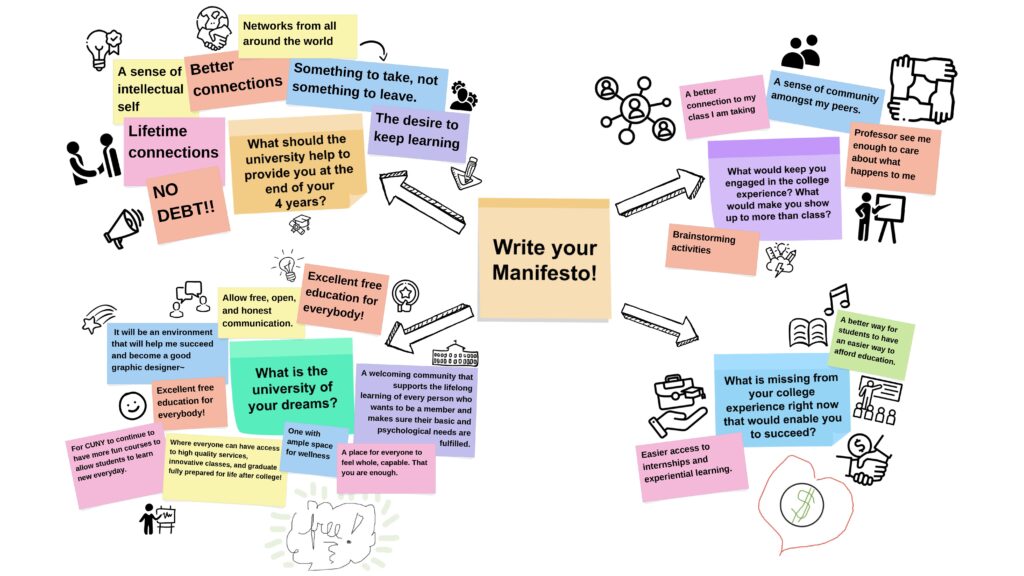Over the three years of the Transformative Learning in the Humanities, over seven thousand undergraduate and graduate students have been impacted by the courses taught by our Faculty Fellows across 21 of CUNY’s two- and four-year colleges in every borough of New York City.
The original goal of incorporating students into grant activities was to improve student engagement and learning outcomes (course retention and performance) for all students, not just those with the most educationally advantaged backgrounds. Improved student learning outcomes will result in better academic and life prospects for students – better college retention and graduation rates, more common entry into graduate work, better first jobs and better careers, more civic and cultural engagement, lives of more meaning and purpose.
- Improved retention rates in humanities courses that use Transformative Learning in the Humanities (TLH) pedagogical approaches
- Improved retention rates in non-humanities courses (“spillover effects”) achieved by applying skills learned through TLH courses
- Higher probability of going on for graduate study in the humanities, greater post-graduate success and likelihood of working in field of study
- Reduced achievement gaps across all outcomes
TLH incorporated and engaged students in a variety of ways. TLH faculty fellows collaborated with students on their public knowledge projects and events. We surveyed students taking courses with TLH fellows. These students were called “Mellon Student Scholars,” which we invited them to list on their CV/resume as leadership and collaborative experience. We formed Fall 2022 and Spring 2023 student advisory boards. We hosted a Student Summit. Student contributions were honored with TLH-Mellon scholarships (advisory board members and Summit participants also received technology to help them with their coursework) and we mentored students on how to use their TLH experience on their resumes, CVs, and in job interviews to help give them a leg up in their careers.

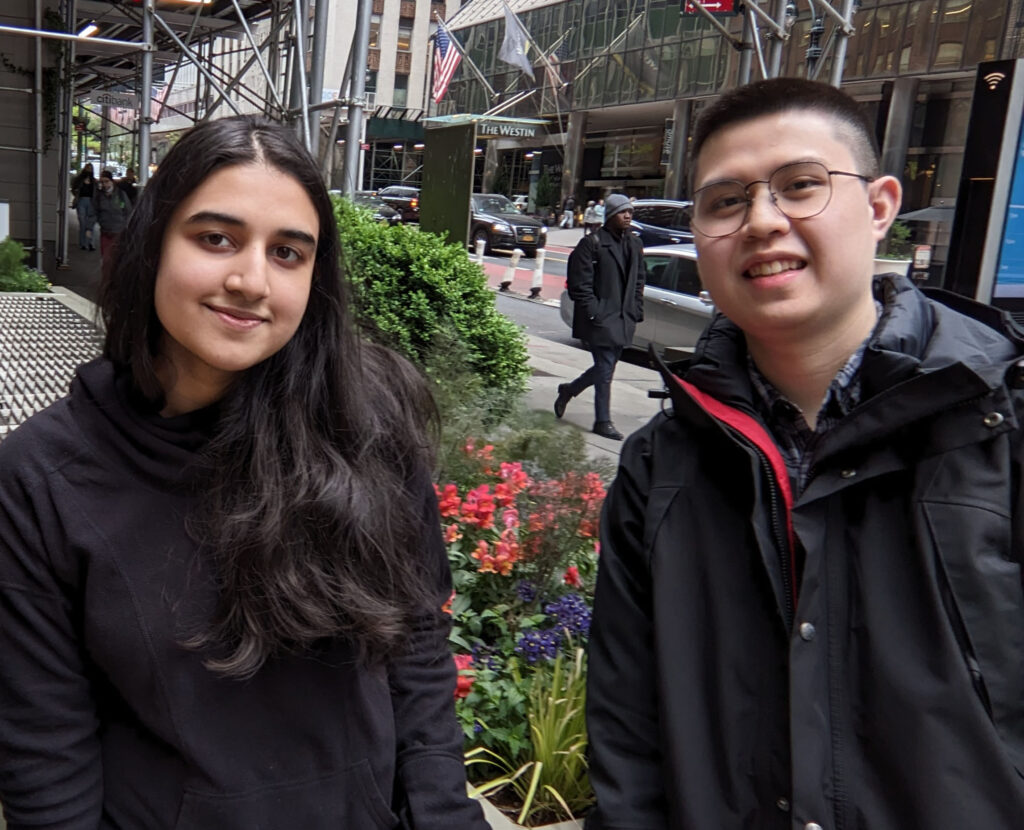

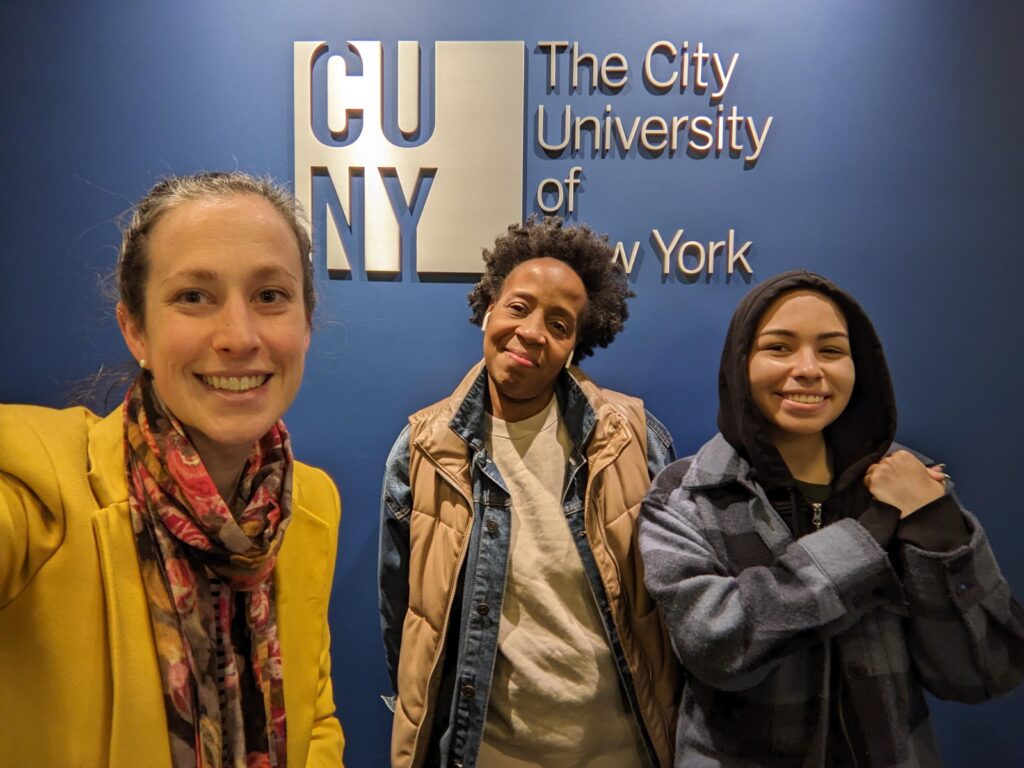
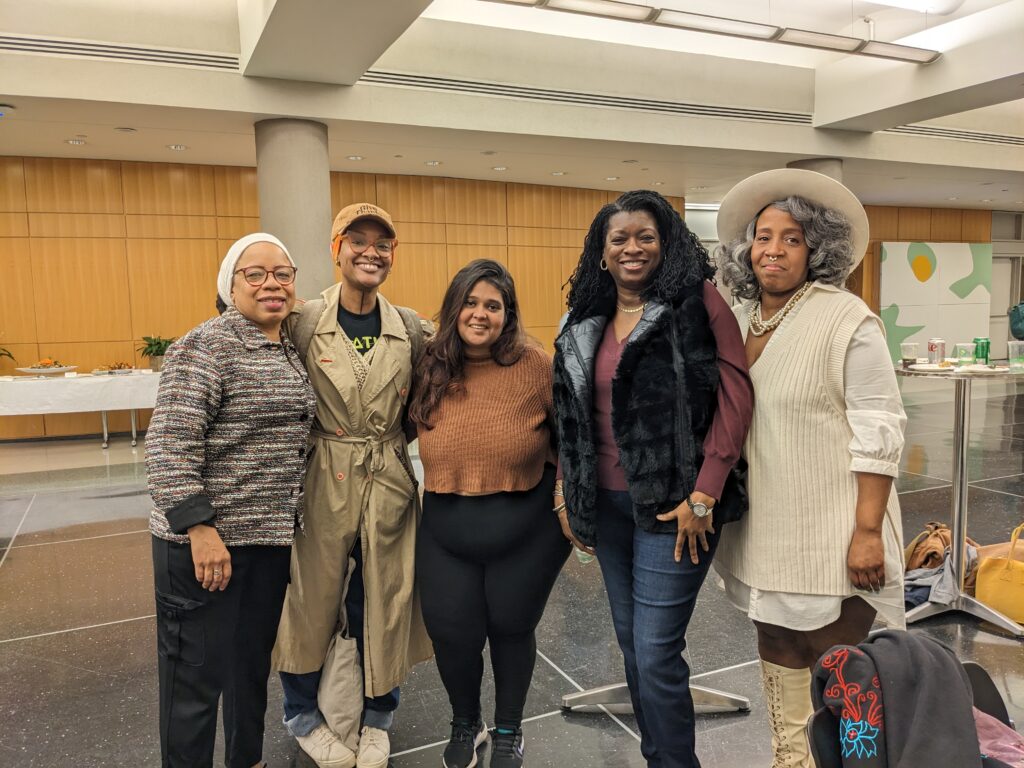
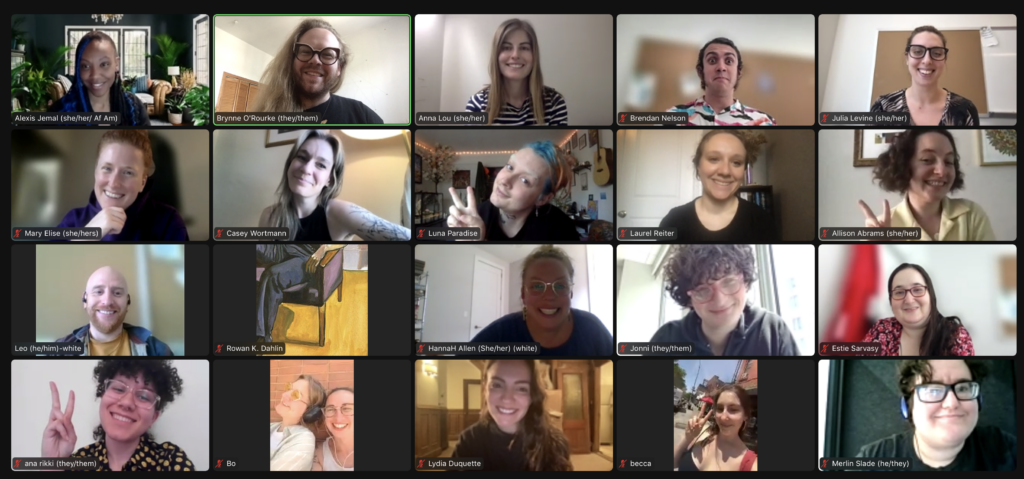
In its last year, TLH formed a Fall 2022 Student Advisory Board of 12 members as well as a Spring 2023 Student Advisory Board of 12 members. To be eligible, students must have been Mellon Student Scholars in a previous semester (Fall 2021, Spring 2022, or Fall 2022), and must have been currently enrolled, matriculated students at CUNY.
The Advisory Board provided an opportunity to give back to the CUNY community by contributing student voices and leadership as TLH worked to forward transformation at CUNY and in higher education more broadly. As members of the Student Advisory Board, students would meet three times (virtually via Zoom) and advise TLH staff on implementing institutional change related to teaching and pedagogy. In these brainstorming workshops, they worked together to craft goals, discuss the work of writers in TLH’s Transformative Speaker Series, and planned the “Student Summit on the Role of Humanities in a Just Society,” a full-day virtual unconference to be held in Spring 2023. The Fall board developed a call for proposals for our Student Summit, and the Spring Board helped review applications and host the Summit on May 5, 2023.
Selected students were from diverse backgrounds and over twenty majors, including: Anthropology, Business, Black and Latino Studies, Computer Sciences, Criminology, Dance, East Asian Political Sciences, Economics, Entrepreneurship, Forensic Psychology, Journalism, Liberal Arts, Nursing, Marketing, and Psychology.
Selecting the Student Advisory Board
In selecting 12 students for the fall and spring Student Advisory Board, the TLH team asked TLH Mellon Student Scholars “Why are you interested in being on the Student Advisory Board”? In their responses, we looked for alignment with the TLH mission, cogency, and leadership qualities. Broad representation across CUNY campuses was key in our decision-making process.

The TLH Student Advisory Board worked together to craft a manifesto from an exercise run in one of our spring meetings. The 12-student board responded to the question “What do you want out of your time on the Student Advisory Board”?
We want meaningful interactions with faculty and administration to understand the needs of professors and students. To understand how best to implement change. We want to introduce experiential learning as an alternative methodology to traditional lecture-based learning modes, with more practical application and interaction with the outside world. We want to make an impact on other students; let our experience in these meetings bleed out into our scholarly lives and into our communities. We want students to have more control over their college careers, and have a stake in their education. We want to help professors understand the best way to teach their classes, from our perspectives and experiences as students. We want to act as the liaison between the CUNY institution and its staff and students. We want new experiences, to enhance our college experience. We want to meet other students and make new friends. We want students to be a part of making the change in the CUNY institution. We want to broadcast different issues, giving CUNY students a platform. We want a positive environment in which to bring issues to light.
Read the collaborative poem constructed from an exercise in a Student Advisory Board meeting:
Building Resilience
What doesn’t kill you makes you stronger
Campus is a camp for all of us,
where some of us snuggle up around the campfire,
while others are looking for the sticks to start
the flame of community.
We are all different and have unique experiences
CUNY Students shine with resilience
And going to college is not always a convenience
But we showcase our perseverance
On the start of my mornings
I think about the sands of achievement
and congratulations
There are certain moments
in which I fear the unknown
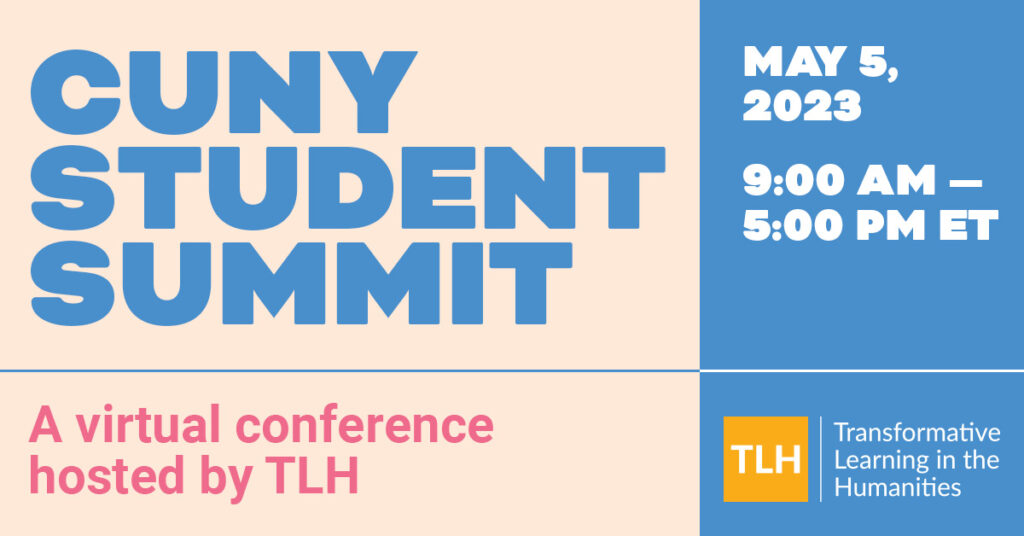
The Student Advisory Board planned the Student Summit on the Role of Humanities in a Just Society, a full-day virtual conference to be held on May 5, 2023. The Student Advisory Board developed the call for proposals for the Summit and reviewed applications. The Summit provided CUNY students a platform for sharing their vision for a more just and equitable academic environment.
Below is a brainstorming document the advisory board used to envision their ideal student conference.
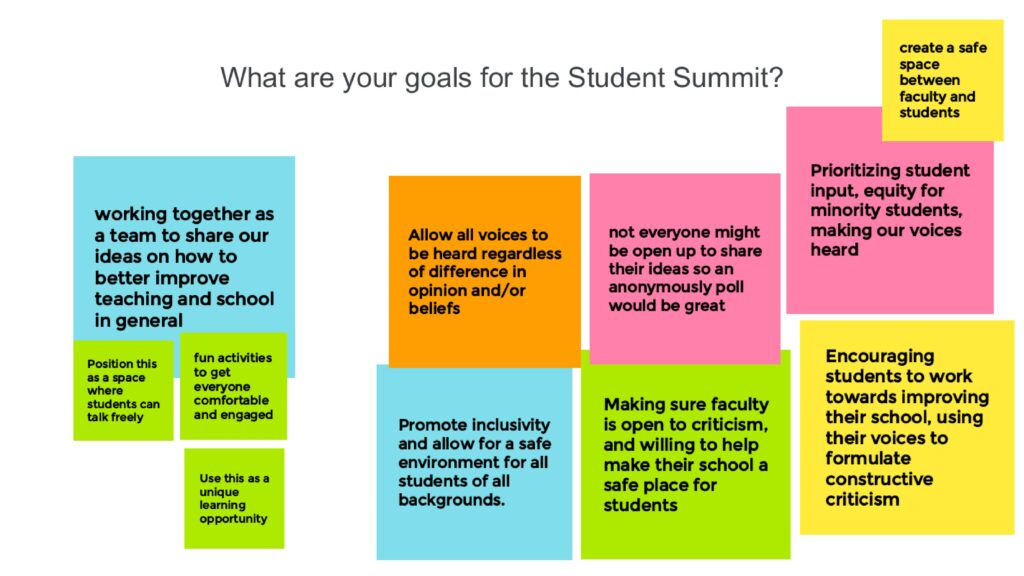
At the Summit, 174 people came together to think about what their college community needs most, and to imagine resources that would improve their social learning experience and academic life. To dream of safe spaces where respect, communication, and transparency are valued. To envision a stripped-down version of the faculty-student relationship, where faculty are better resourced themselves to be able to put students’ needs first. To conceive of concrete ways in which CUNY administration can better respond to issues raised by students.
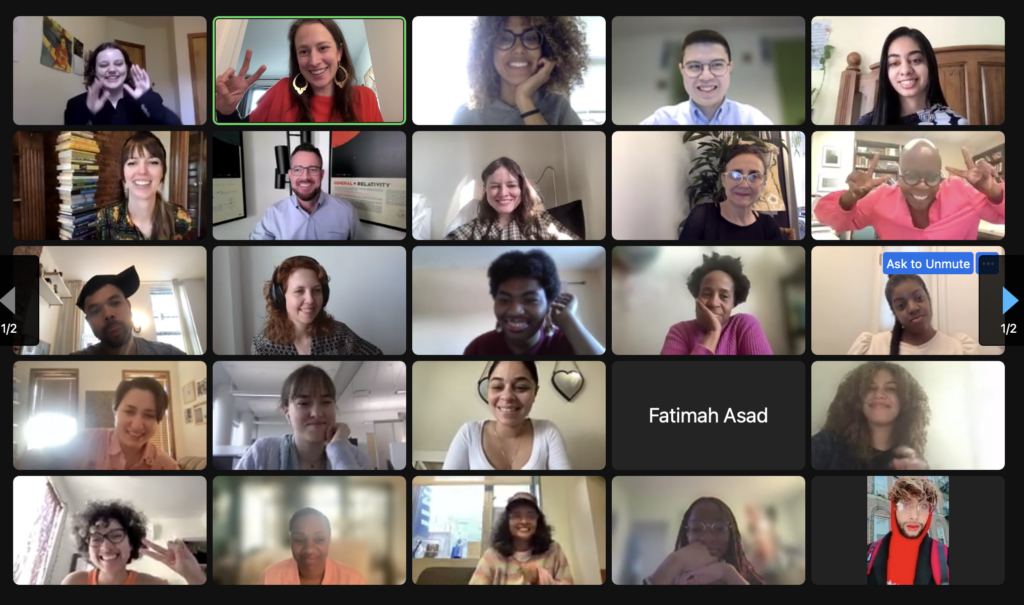
After the Summit, students were encouraged to share their projects in different media formats and partake in short reflective interviews on their participation in the Student Summit:
“I’d just like to say thank you so much for your guidance throughout my TLH journey. It has been a pleasure working with you both, and I’ll cherish my time on the student advisory board forever. I had an excellent time participating in the summit and I enjoyed our meetings. I truly feel like we have made change and I can continue to help change the world of education and pedagogy. Will definitely be checking in with you both.”
Student Advisory Board Member
Students were given the opportunity to have their projects published as part of this OER (Open Educational Resource). Their work will be memorialized and shared as part of a better CUNY we all envision through this grant.
- Project #CUNYCleaned
- Care Off Campus
- Critical Pedagogy and Our Syllabus
- Student Clubs
- STEM and Social Studies
- The Need for Ethnic Studies
- Nontraditional Students
- Mentoring
- Manifesto Design
- Embroidery
- Project 19


After the Summit, students were given the opportunity to participate in a reflective interview. Below you can find the questions and select answers from students:
What was it like serving on the Student Advisory Board?
“Serving on the student Advisory Board was a scary moment for me. I didn’t know what to expect at first but meeting the fellow board members was very relaxing, and I felt very welcome. I found out that this was going to be a journey of meeting new people and I will be able to explore new ideas and what I signed up for was not in vain. What I was not expecting was to enjoy and be thrilled by being a member of the advisory board.”
Tahisha Fields
It was a really great experience getting to interact with fellow students who were going through it with me. The group setting was comprised of other students of different backgrounds and diverse experiences. I learned more about what college is like for other people and how that dictates how I experience it.
Holliday Senquiz
What was your favorite moment of the Student Summit?
“My favorite moment was when everyone started to present, and I saw how well everyone was coordinated and how all the ideas could be utilized for my campus and others.”
Joey Poon
How would you describe the university you want?
“For me, I accredit CUNY to this – I’ve been able to be a part of a lot of social justice groups and that really shaped my view on universities. I want a university that is free and doesn’t just see students as a bank, pressing them for money and ensure that every student has access to every resource they need – and that makes sure that when you’re struggling financially, they have scholarships and grants available. Every student is heard; the admin and faculty know students. Not where only a select few students are awarded and praised because there is disparity between students who are acknowledged for their work and those who are just pushed aside.”
Onyekachi Okeke
What was your greatest takeaway?
“Realizing I’m not the only one who sees these issues (presented at the Student Summit) and that faculty and students agree that students need more financial aid and resources. Others also want to create this change, make school more accessible, and it’s very reassuring to know that and plan to make a change in the community.”
Yanira Rivera
“One thing that stood out was about the experiences of those first-generation or coming from another country, how hard it is to integrate into collegiate experience. Colleges think they’re helping and students seek help, but there’s a disconnect – sometimes it’s pride. It still needs to be addressed, so people can get assistance they need.”
John Flack
Tell me a little bit about how you prepared for this event. What was the mentoring process like for you? How did you come up with your idea for your presentation?
“I based my presentation on Paulo Freire Pedagogy of the Oppressed and I didn’t have solid plan before meeting with Yuma (Carpenter-New). I then got the idea for a syllabus and ran with it. After that, Christina (Katapodis) helped with adding interactive ideas for my presentation. Both Yuma and Christina helped when I had a raw idea but not an executed plan.”
Bahia Selma Sihali
What skills did you practice and use that will be useful to you in your career and life?
“English is not my first language, so I have difficulty with engaging, which is really important for becoming a lawyer. I got to work on presenting and engaging at the Summit. I’m very glad I participated.”
Byran Tapia
What advice would you give to someone who wanted to do a similar project?
“I would say if you find yourself being stuck with where to go and where to start, look for student organizations that are centered on change. I was able to get ideas and help from a lot of organizations – it helps with bridging gaps and makes you feel like you’re not alone. If you’re hitting resistance with peers or administration, don’t let it stop you. That’s what I faced, and I wish I didn’t let that deter me for a while. Remove yourself from these spaces and sometimes It’s good to work alone. Gather your thoughts and see what it is you want to do – you’ll be surprised to find out there are a lot of people who are interested in your project. It can take a while, like it did for me, but the Summit let me show people my project and it inspired me.”
Onyekachi Okeke
A Note on TLH Pedagogical Methods
The Transformative Learning in the Humanities (TLH) program fosters the democratization of the humanities classroom through what is known as active or participatory learning. Such a transformative model prepares humanities students for a world that requires collaboration, written and spoken communication, project management, critical thinking, analytical reading, cross-cultural thinking, and ideation. Numerous studies, such as those conducted by Google’s Project Oxygen (2014) and Project Aristotle (2017), have demonstrated these skills are key contributors to success in the workplace and in communities and, we hasten to add, to success in the rest of a student’s education as well. Through participatory learning—a method where both faculty fellows and their students learn through a carefully structured pedagogy designed for contribution—every student not only gains essential skills but can see the ways those skills can have an impact on those around them.
TLH participatory methods draw on long traditions of active learning with genealogies in progressive education back to Maria Montessori and John Dewey, radical pedagogy (Paulo Freire and bell hooks), and a variety of contemporary, engaged pedagogies (such as those espoused by guest speakers in our Transformative Speaker Series), including those inflected by social science (such as the work of Carol Dweck on fixed versus growth mindset).
What Makes TLH Methods Innovative, and Why This Matters
In the traditional teaching model leveraged in college humanities classes, a teacher lectures to supplement reading students have done independently; the teacher then opens the class to discussion, usually by asking a question and prompting the students to respond. Typically, one or two students will raise their hand and offer an answer; the majority of the class tends to remain silent. This becomes a trope through the semester, with the course unfolding as a discussion between the teacher, viewed by the class as the authority figure in the room, and those few students who regularly speak up and proffer their opinions. The bulk of the discussion portion of the class is blanketed by an uncomfortable silence, with some students seemingly disengaging from the topic of discussion altogether.
When faculty do not use participatory methods and rely solely on traditional models, most students never contribute or say a word throughout the course, and the teacher has to chiefly rely on term papers and other independent writing assignments to divine what the students have learned from the course. In short, the traditional humanities teaching model typically eschews total participation of the students and the teacher and thus presents itself as an undemocratic pedagogical model, the problems of which are multifold and long-lasting, especially for first-generation college students and first-generation Americans.
This undemocratic model, first and foremost, reinforces inequity and bias within the classrooms in that the students who are most vocal in class tend to be students who self-identify with the teacher in terms of race, gender, age, or ethnicity. Such a dynamic creates an echo chamber effect while the diverse and ostensibly valuable opinions of the students who stay silent are lost. Such a dynamic is anathema to TLH’s and CUNY’s mission of activating and capitalizing on diversity in the learning process.
Another problem with the traditional model is that students exit the course having had an insular experience rather than a communal one; the vital skills of collaboration and cooperation have not been nurtured. In the end, they walk away from the course without a deep connection to their peers or to the material that had been taught in class. Some students may even reflect on their in-class experience and wonder what the utility of humanities classes is in the first place.
To remedy the confluence of problems presented by the traditional model, TLH helped faculty fellows to design and deliver humanities courses that leverage the model of what the American Psychological Association calls “Total Participation,” a method where each student is given a “voice” in the classroom, learning from peers as well as from the instructor. This participatory method is how we all learn outside of school, i.e. through democratization, application of principles to a problem, active involvement in the learning process, and, ultimately, original and meaningful research.
Numerous studies have shown that participatory, active learning methods are more effective than traditional one-way methods such as the lecture or that selective methods common to the typical discussion or seminar course. Two massive “meta studies” (PNAS, 2014 and 2020) of over 225 separate studies using a range of assessment methods (course completion rates, test scores, surveys of retention and applicability beyond the classroom and others) conclusively support the superiority of active learning. Of particular note, the second PNAS study was specifically focused on the gains that first generation and other underrepresented students show through participatory/active learning methods.
The TLH model employs techniques that solicit participation and higher-order thinking from all participants at the same time. TLH also emphasizes the deep and broad skills students learn through participatory methods, allowing students to come away from introductory humanities courses with a remarkable tool set of essential skills that are too often passed over in the traditional humanities classroom.
How it Worked
A key component of the faculty fellows’ selection process was asking applicants to propose ways that they would include their current students in this active learning process. Almost all fellows were teaching concurrently with the TLH seminars so they could practice using TLH teaching methods in real time in their courses. Originally, we anticipated that as many as 6,000 or more students in fellows’ courses would benefit immediately from this 3-year grant. By the end, TLH supported over 7,000 students and over 100 faculty leaders on campuses all across CUNY.
View forms students might expect to receive in a participating fellow’s class:
Students taking faculty fellows’ courses were invited to collaborate on Public Knowledge Projects that showcase and explore TLH teaching methods. Students participated in creating websites, podcasts, Instagram conversations, and more. They contributed insights from their perspectives as students at public events and in ongoing TLH-CUNY conversations. You can learn more about the projects students contributed to by following the links below.
Student Self Portrait Artworks created by LaGuardia Community College students in the workshop Seeing Each Other: Identity Self-Portraits
- Kyana Neil
- Daniel Herrera
- Giulia Armentano
- Scottie Norton
- Teshaba Barlow
- Noelia Carrasco
- Kristen Chan
- Lucas Neira
- Liah Paterson
- Zonghua Zhang
- Tanesha Jenkins
- Rongxin Xu
- Nour Mohsen
- JunHui (Erik) Chen
- Alvaro Chavarriago
- Leuvy Alvarez

This is a representation of my activist side and my normal side. By bringing art and social justice together, I decided I wanted to remake a famous painting by Norman Rockwell. My head is served on a silver platter, hard to ignore, but I have very vibrant 60s/70s influenced makeup on. I’m surrounded by people laughing and talking, but all of the white people surrounding me have copied my makeup… and now the laughing seems to be more of a “haha we look just like her.” I tried to connect the “Culture Vulture” experience people of color always go through. Famous celebrities like Kim Kardashian and Gwen Stefani are infamously known as Culture Vultures… they wear people’s culture like it’s a costume. (From Asian, Native American, Black people, and much more!) And me a person of color, surrounded by white onlookers is having the first-hand experience of only being a “thing to eat, or to take from.”
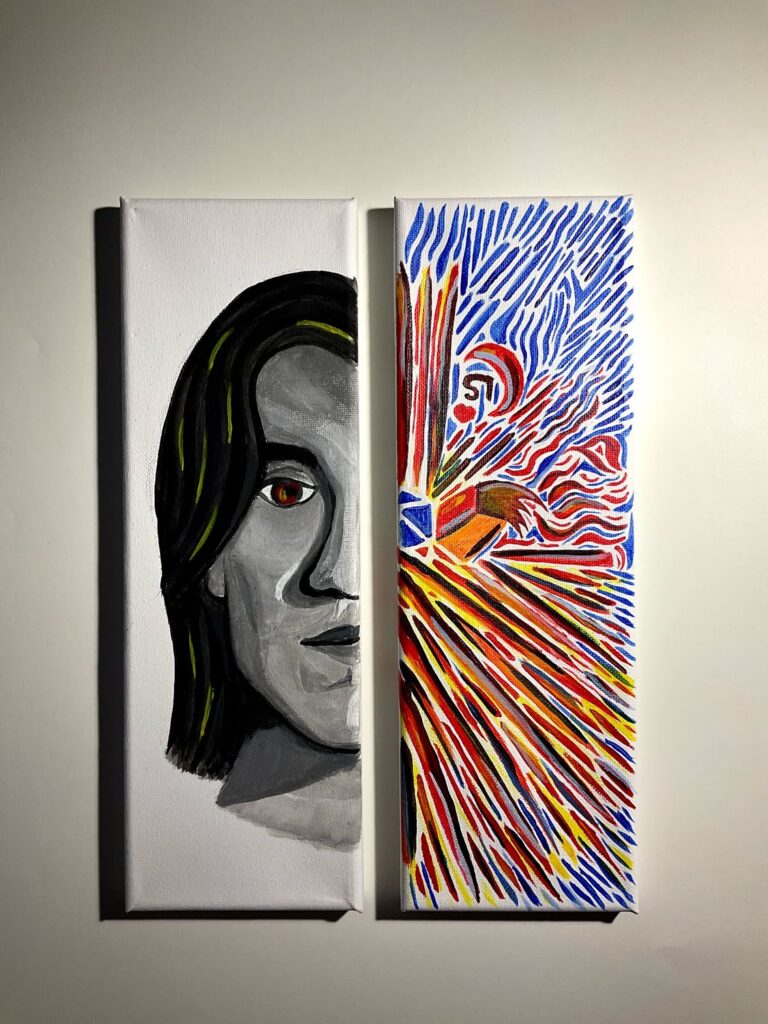
I am Industrial Design major at LaGuardia Community College and a future Architecture major at City College of New York. I wanted to show a physical and creative representation of myself. To illustrate this idea, I divided the painting into two pieces. The left side shows my physical self-portrait and the right side represents the creativity coming from my mind. I painted a color explosion full of different paths and figures in contrast to the realistic representation of my face.
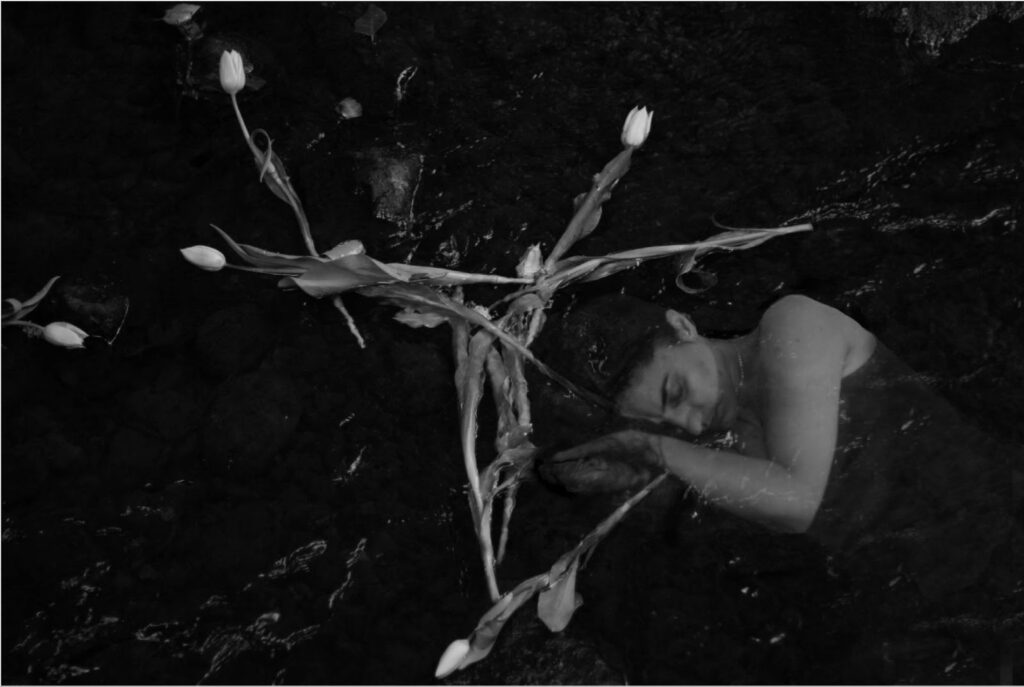
The work is a reflection on the experience of grief. To create my portrait I went through photographs I recently shot and decided to combine two of them together in Photoshop. Even though letting myself feel the pain is hurtful, it can also be comforting, an idea rendered by the image of the water carrying me.
I found the workshop interesting in how it showed the different ways in which artists think about themselves and their approaches to describing the aspects that make up their identities. This has given me more confidence in expressing something which, although it has been redefining my entire self, I am not comfortable sharing, even if just through my artwork. Hearing others describe their portraits was rewarding because I learned a lot about the creative process involved in the realization of works that are very diverse, although they were made by people who, at least partly, share the same educational path.

I used a 3D rendering app called Blender to create an 8-second looping animation called Late Bloomer (and a still 2D image seen below), a figure representing myself with flowers cascading out of his head, and five hands surrounding the body.
As a non-traditional student, this artwork represents me pursuing my passion of becoming an artist and “blooming” or discovering my power through art after years of working as a retail manager. Each of the hands represents something different. I chose the image of the pencil in white and the black goblet to represent the positive force of creativity and the negative concept of vice. The black hand around my neck symbolizes self-doubt and self-destructive behaviors. Last year I was involved in an attack that broke the right side of my face, and this artwork symbolizes me overcoming this event and emerging with a newfound sense of purpose.
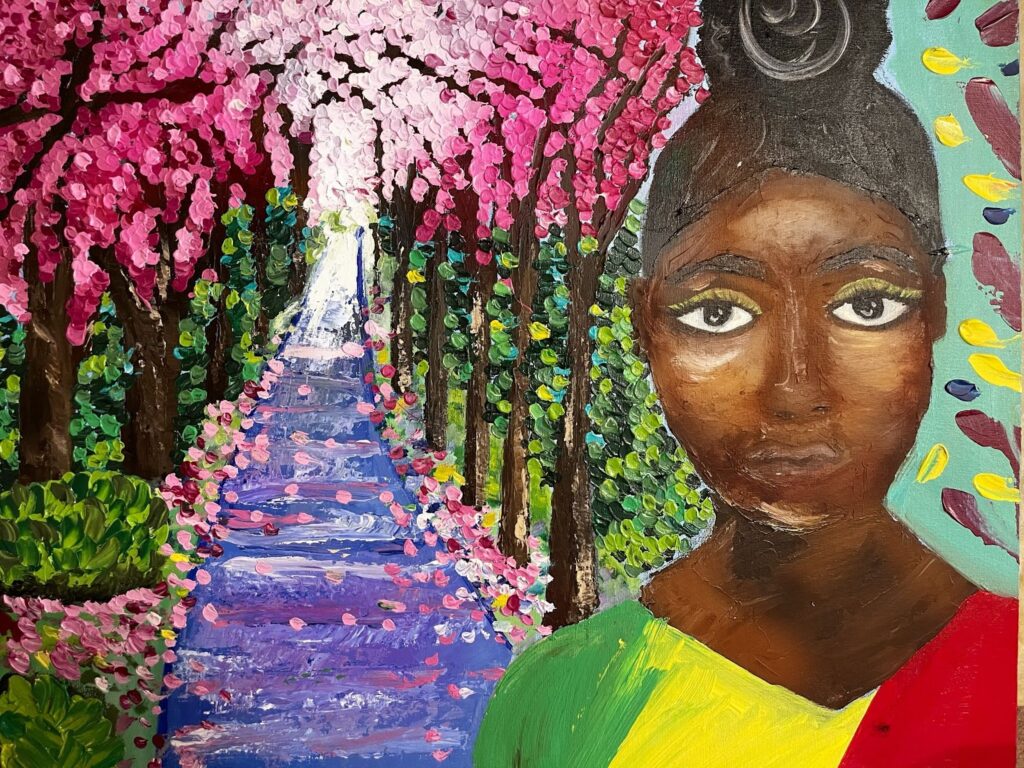
The work that I made was about working with the materials that I love and reflecting on why I choose to major in Fine Arts at LaGuardia. I painted myself and park-like scenery in the background, with a burst of cherry blossoms on the trees. The workshop helped me identify certain aspects about myself. Some of the words to describe myself in the workshop activity are: an artist, a woman of color, a naturalist, a palette knife, and Guyana, which is the country I come from. I started to sketch in charcoal. After, I painted. Working with thick layers of paint and a palette knife is always fun for me.
My experience with hearing other people describe their work in the workshop discussion was altogether great. I enjoyed listening to everyone’s backstories, or struggles they faced with the project. I thought some were inspirational. And I found myself relating to them.
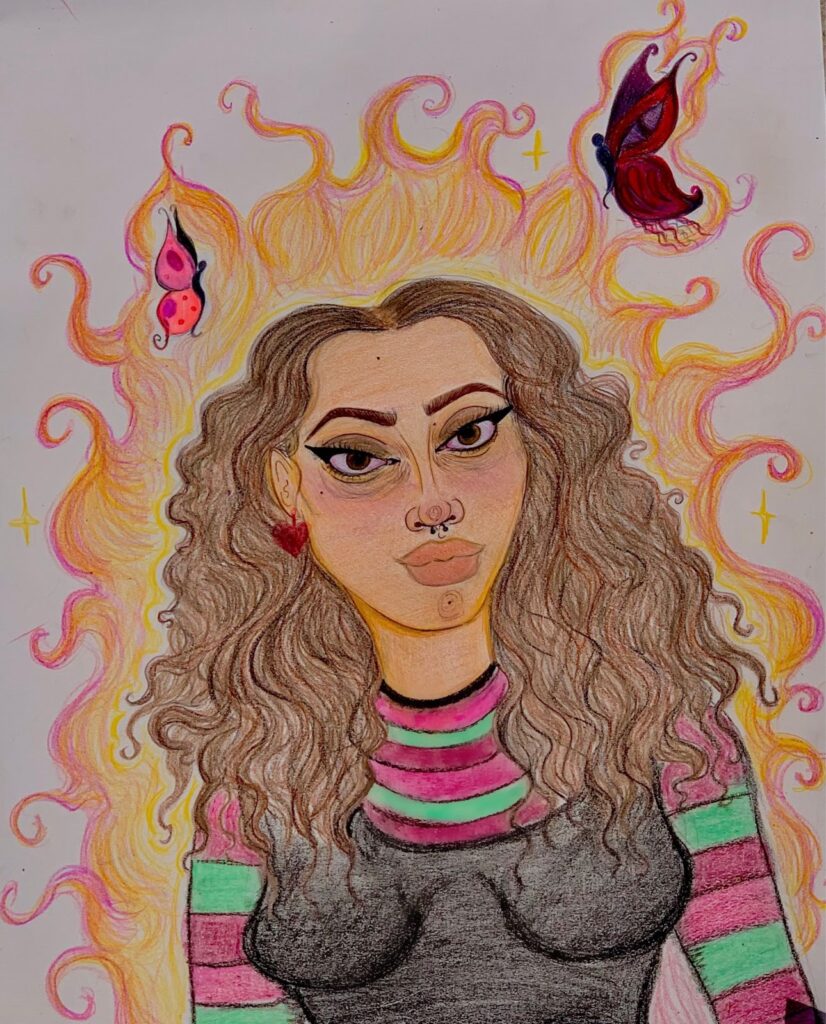
I loved seeing everyone else’s work, which gave me a sense of what other kind of artists there are in the world and OUR SCHOOL!!
[Self-portrait description: Drawing of the head and torso of a woman with long wavy brown hair, cat-eye makeup, and a nose ring. She is wearing a long-sleeved pink and green striped shirt under a black tank top, and an earring in the shape of a red heart. Two butterflies are flying above her and a halo of flames surrounds the butterflies and woman.]

I am an Asian American artist from Hong Kong, currently studying photography at Laguardia Community College. I chose to base my self-portrait on five words that identify who I am, and repeat them over and over until they fill a silhouette of myself. The words “Asian American”, “Dreamer”, and “Immigrant” all refer to my identity as a Chinese immigrant growing up in America, while the words “Gamer” and “Artist” refer to hobbies important to me. The silhouette features a girl wearing floral hairpins. Such hair ornaments are typically matched with traditional Chinese hanfu clothing. The black silhouette was drawn using the software Procreate and text added on in Photoshop.
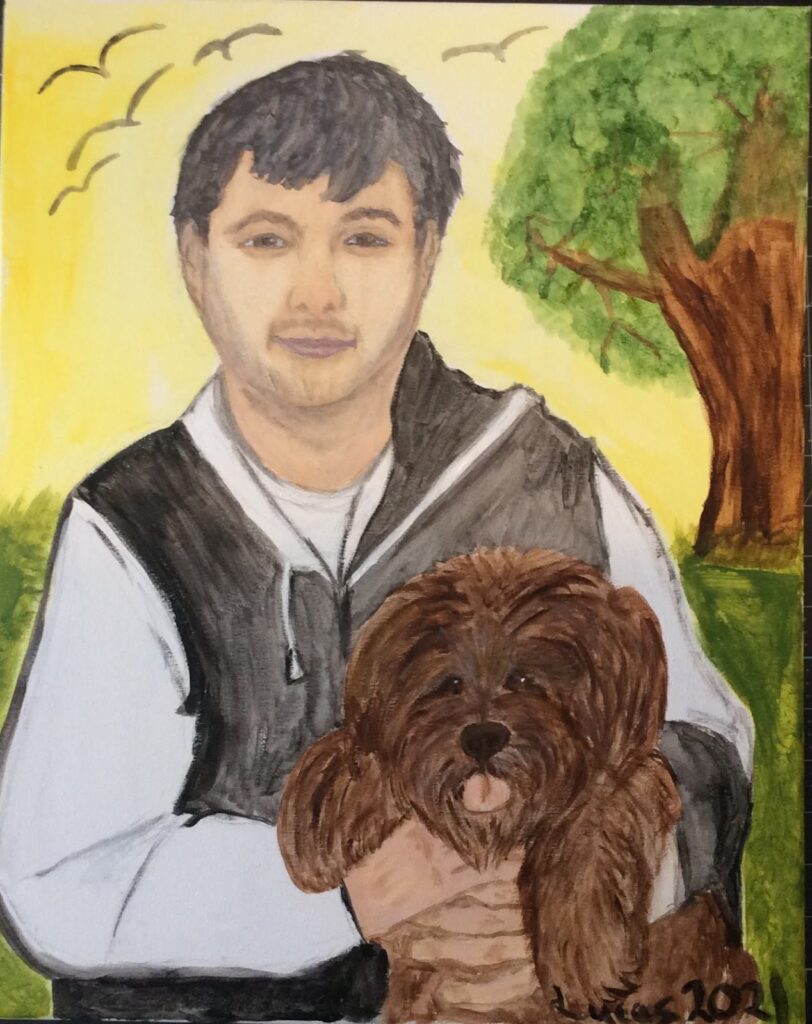
Art is about freedom and life. This portrait is about me and my dog. I painted the sky yellow because yellow means joy and happiness. The reason I’m happy is because the dog symbolizes a special key to achieve my smile. I always wanted a dog and now I finally have one. I named him Choco and he is a beautiful brown shih-poo. He is my 21st birthday gift and I am so happy for what I have.
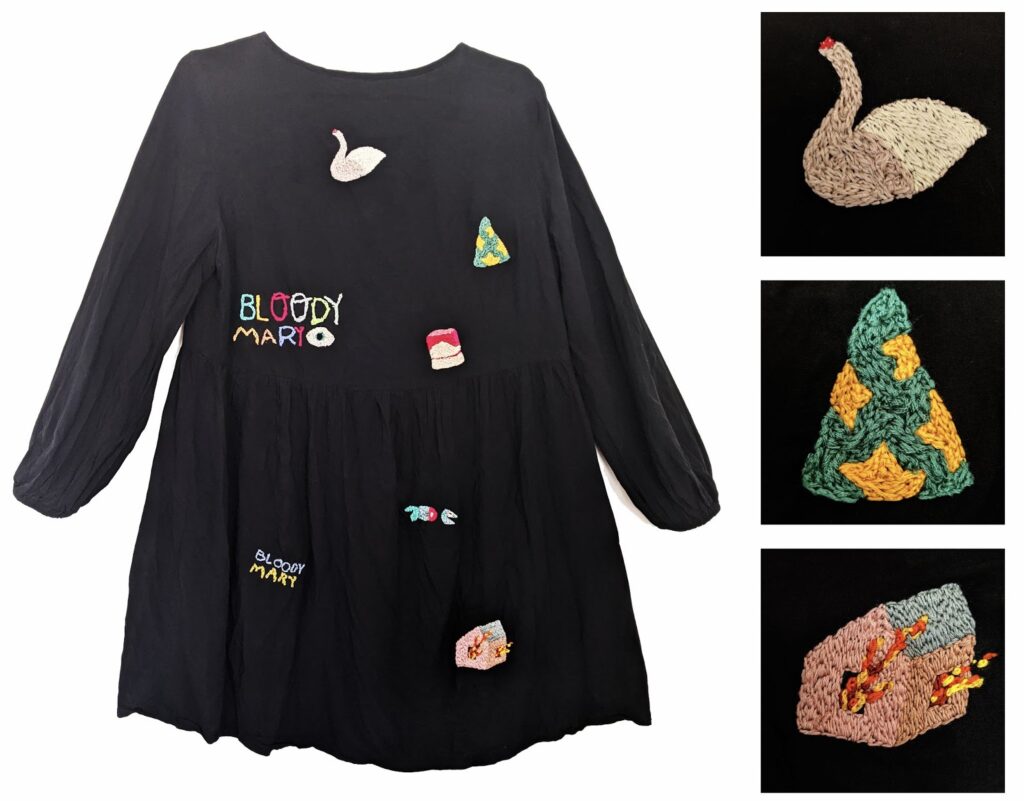
I loved the idea that self-portraiture does not have to be a literal image of one’s face – something that I had not previously thought about before this workshop. I sewed symbols onto an article of clothing. The symbols represent specific family lore and imagery present in my childhood. It was difficult to challenge myself, to not only pick up embroidery after a five-year hiatus but to identify strategies to allow the imagery to maintain what I often try to capture with paint – an eerie familiarity, a questioning of what tales are behind this image.
[Self-portrait description: photograph of a black dress with embroidered words and symbols with close-up images of a duck, a tree, and house with flames coming out of the window]
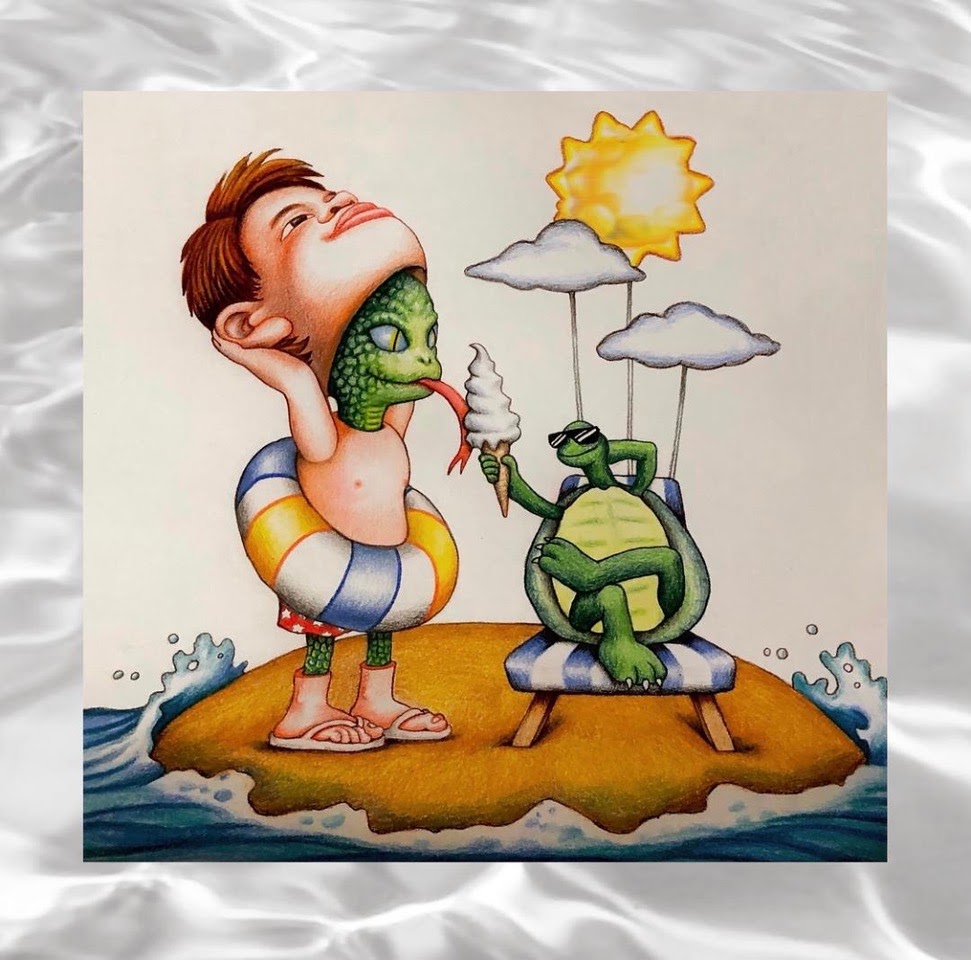
Hand-drawn with multi-colored pencils, I created a lizard man — a scene with a joyful atmosphere to show a true me and my love of reptiles. It was a fantastic experience to join the workshop. It brought me to a wider horizon level to understand what self-portrait is and can be shown from many different perspectives and it also can be expressed in different techniques. I’m really happy to see other classmates’ artworks, full of unique creative ideas that inspired me. It was a good opportunity to share our ideas and learn some new styles of art from others.

The 5 words that came to mind to describe myself were creative, photographer, artist, magical, and extravagant. I like to embrace the concept of black hair with visually beautiful details like flowers, butterflies, plants, colors, etc., and make it over the top to place emphasis on its versatility and beauty. I used glitter and crystals as a nod to the “Black Girl Magic movement” which celebrates the beauty, power, and resilience of Black women. She’s holding a camera because I’m always taking pictures.
I loved all of the examples and styles of what a self-portrait could be. I even researched some of the artists that I heard of for the first time in the workshop. I wish there was more time to see everyone’s work because it was fascinating seeing how other people portray and think of themselves. The creativity was great and now I actually want to play around with digital art. Great workshop!!!
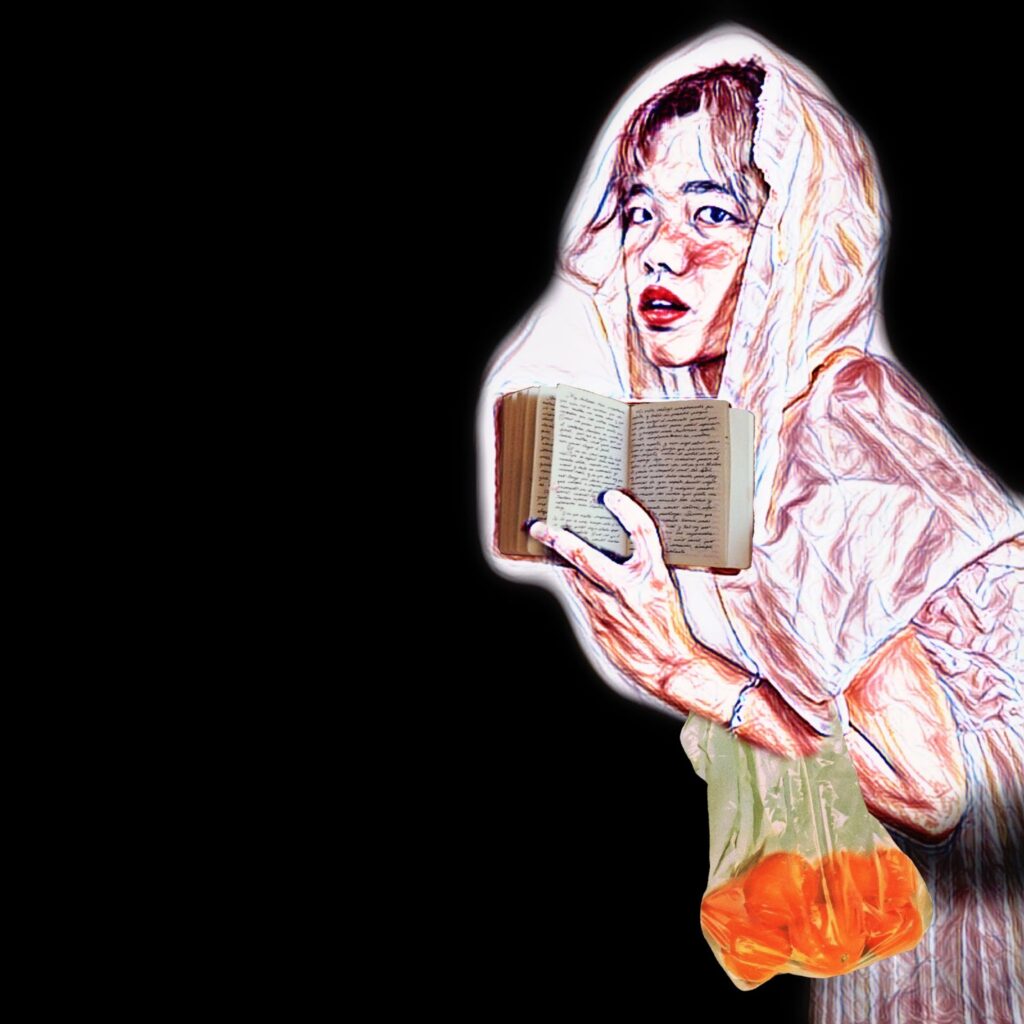
[Self-portrait description: digital painting of a woman wearing a hooded pink coat, holding a book with handwriting open with one hand, which is also carrying a bag of mandarin oranges]
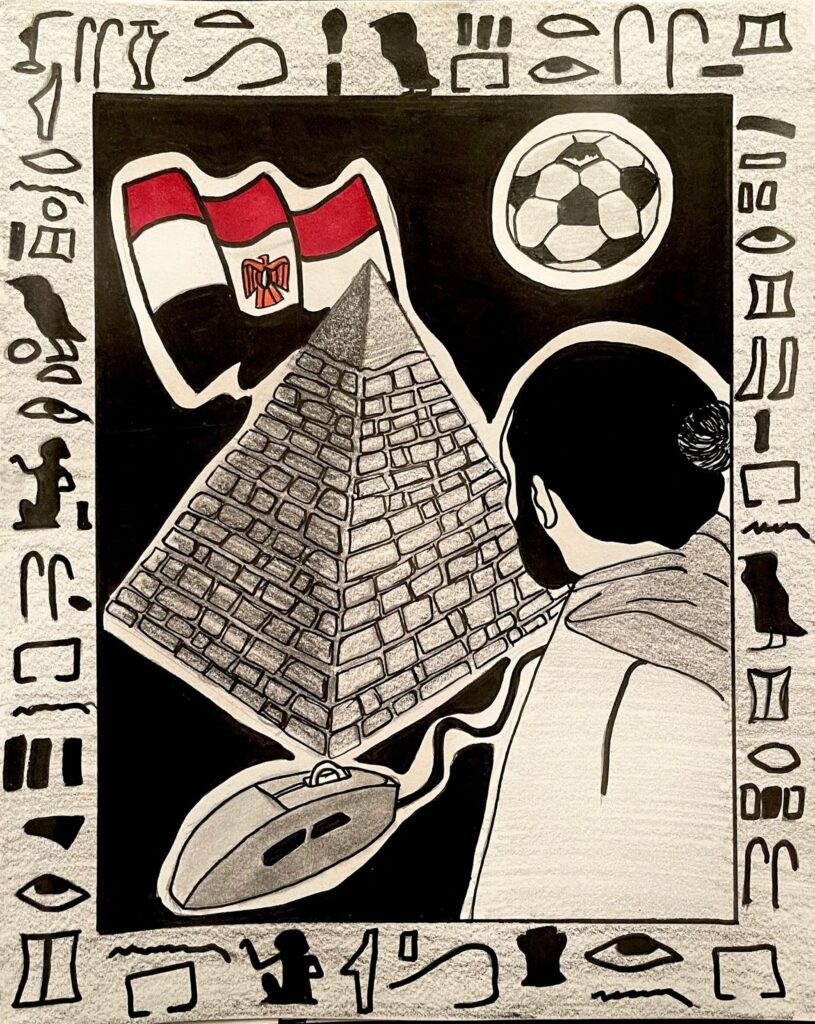
I am studying Industrial Design at LaGuardia Community College. In my self-portrait, I decided to draw one of the pyramids, of Khafre (خفرع), in the background with the Egyptian flag above it, representing my culture. As all Egyptians, I love football, so I represent it in my self-portrait with a (Soccer) Ball symbol. I played video games from when I was 10 years old. I drew a gaming mouse in the bottom left of the portrait to represent how the gaming world took place in my life. I connected all those symbols with a drawing of myself looking back toward the things that represent myself both past and present. For the border, I used the ancient Egyptian language (Hieroglyphics). I used a pencil and a marker on a drawing pad.
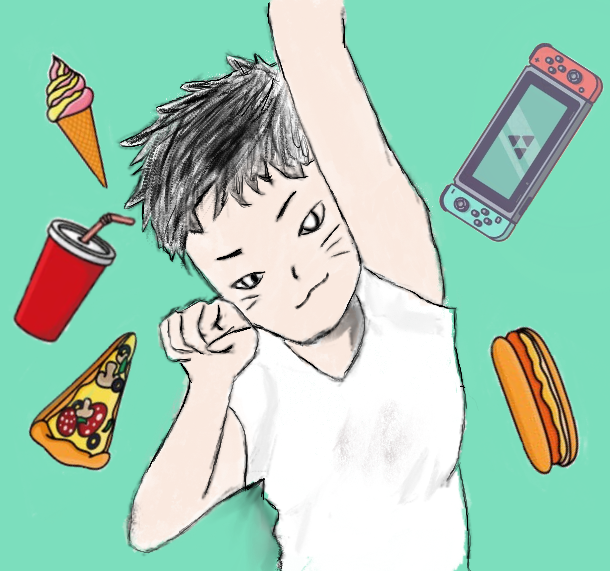
The five words I chose to describe myself in our workshop “Seeing Each Other: Identity Self-Portraits” are freedom, curiosity, loner, nervous and slow-to-warm-up. When I see these words, I think of cats. I consulted cats’ movements — like when they stretch their waist — and combined them with a human, plus some of my characteristics such as short hair and wearing a T-shirt.

My self-portrait is based on my own experiences, struggles, and battles to get ahead in this country as an immigrant. I chose to draw my hand because with it I can create a lot of things and help many people. My hand represents what I am and what I came to do not only in New York but as a Human Services student at LaGuardia Community College: Educate myself to help others.
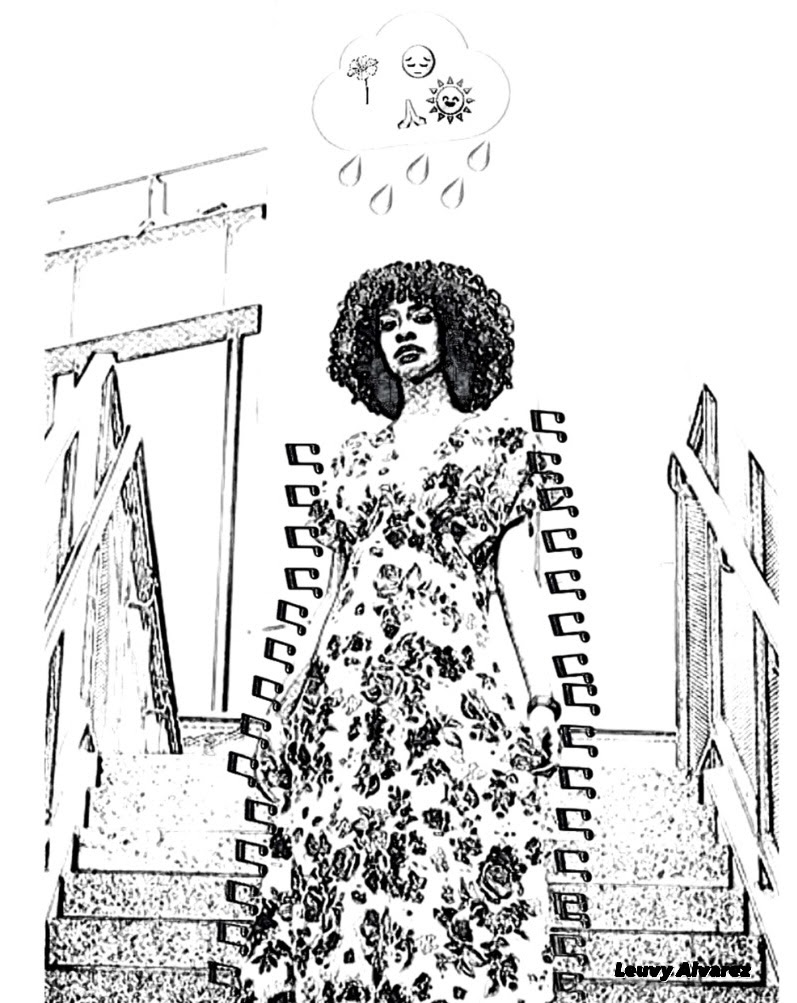
I am a future teacher from LaGuardia Community College who loves art. I made a self-portrait using a photoGrid app. The photo I used in this picture was taken by one of my best friends as a model for her page, which is a small business clothing page, where I had to show my confidence. I’m using music notes as my arms. A raining cloud in my head includes a sad emoji, a flower, a sun, and a thankful emoji. The objects in the cloud represent insecurities, sadness, hope, and thankfulness. The rain represents growth: Flowers need rain to grow. Music makes me stand despite the war of emotions.
In We Want to Do More Than Survive by Bettina Love, the chapter “Freedom Dreaming,” posits that artistic mediums can be utilized as a way to express individuals’ unique narratives while shaping their visions for the future. She writes:
“Writing, drawing, acting, painting, composing, spittin’ rhymes, and/ or dancing is love, joy, and resistance personified. Art provides more to communities than just visual and sonic motifs: it is one of the key ingredients to a better world. Art that inspires for a better world. is rooted in intense design, research, and musings for justice filled with new-world possibilities. Social justice movements move people because they ignite the spirit of freedom, justice, love, and joy in all who engage with the work. Art helps people remember their dreams, hopes, and desires for a new world.”
This TLH Knowledge Project will engage with the artistic medium of zines in order to call upon our personal narratives of “new world” possibilities, for our education and beyond. This zine project poses multiple questions to its participants/contributors – how did you make your way to CUNY? What led you to pursue an education at this singular moment in history? How can we document our unique educational and personal narratives and how do these stories relate to the limitless potential of re-imaging a new CUNY? What do you envision for the future of your education and how it relates to the opportunities provided by the CUNY system? This project will incorporate various mediums of contributors’ choice such as poetry, memoir, collage, visual & digital art, as well as interviews.
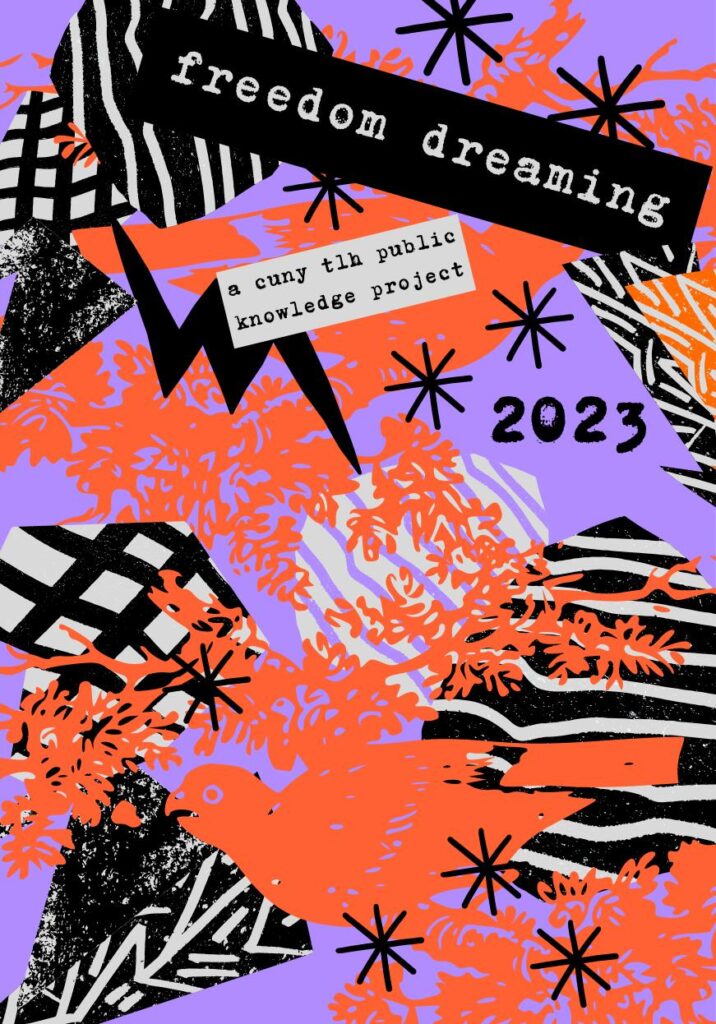
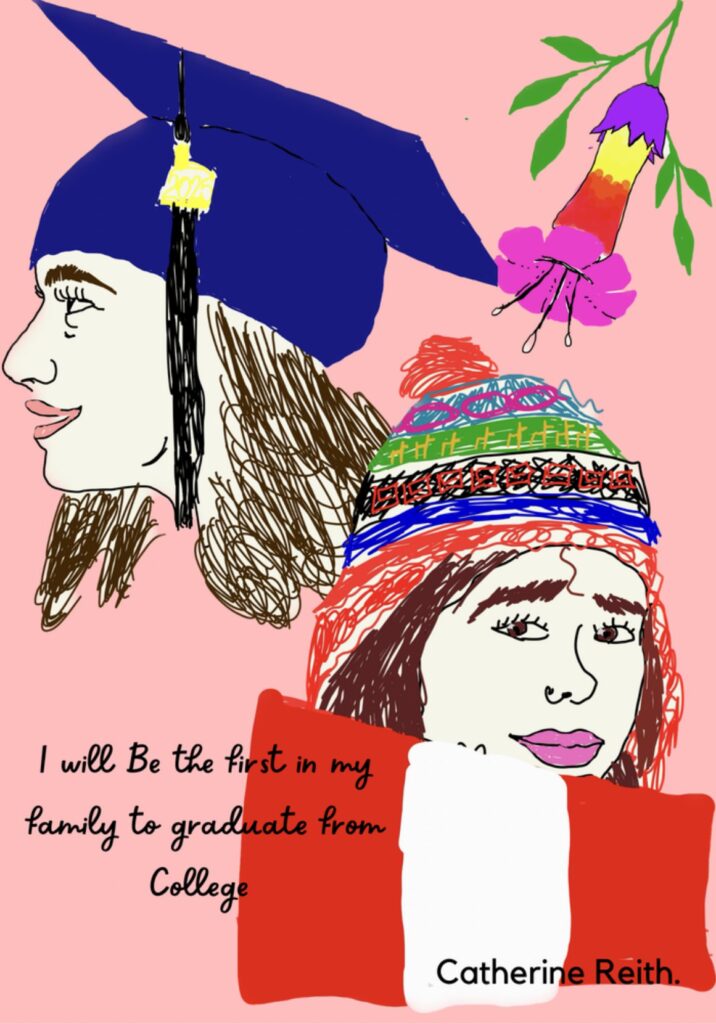
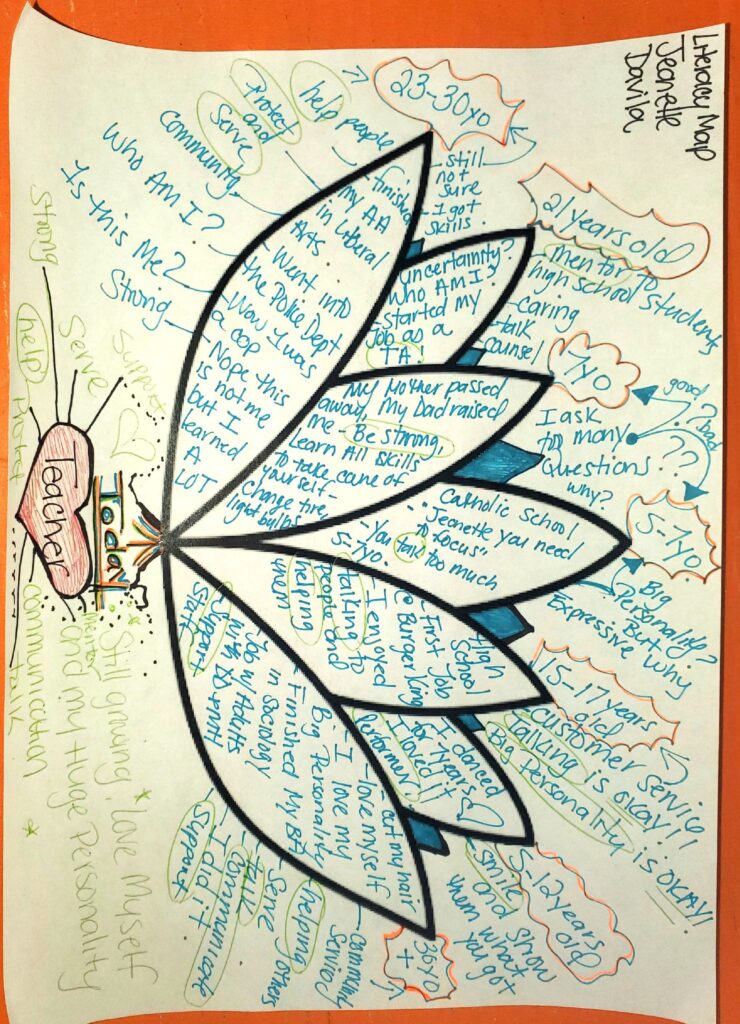
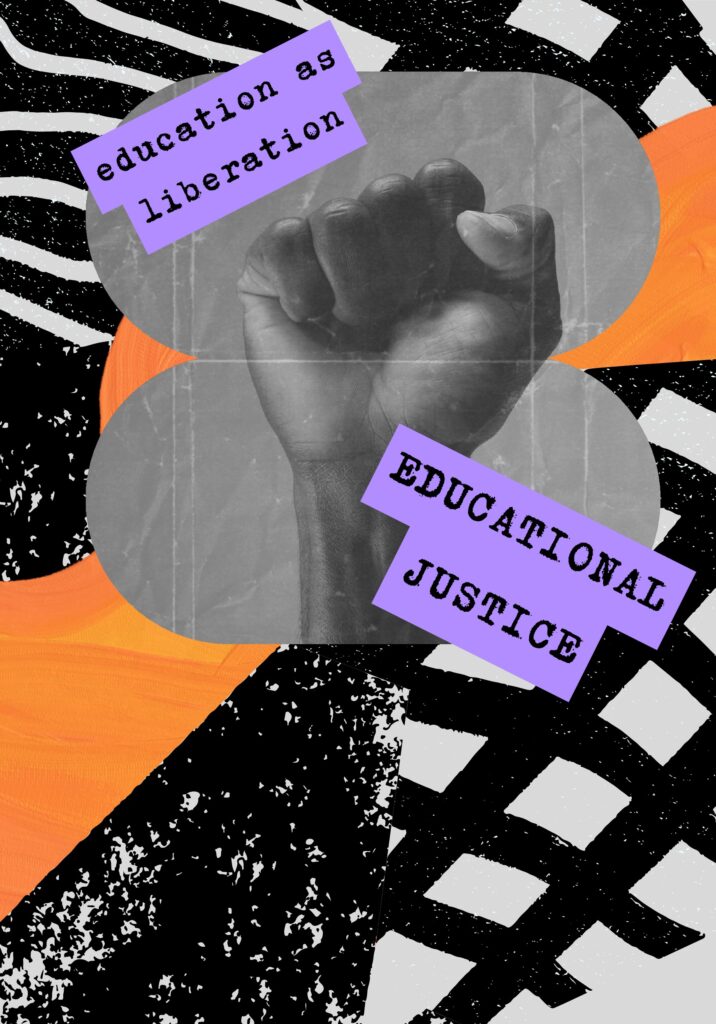
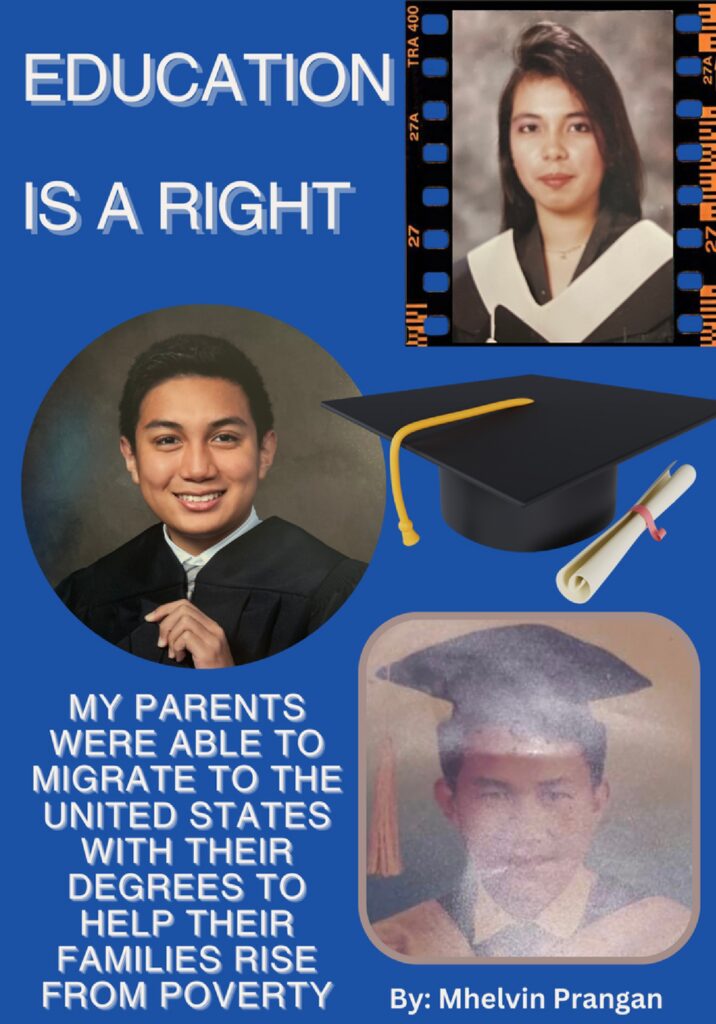
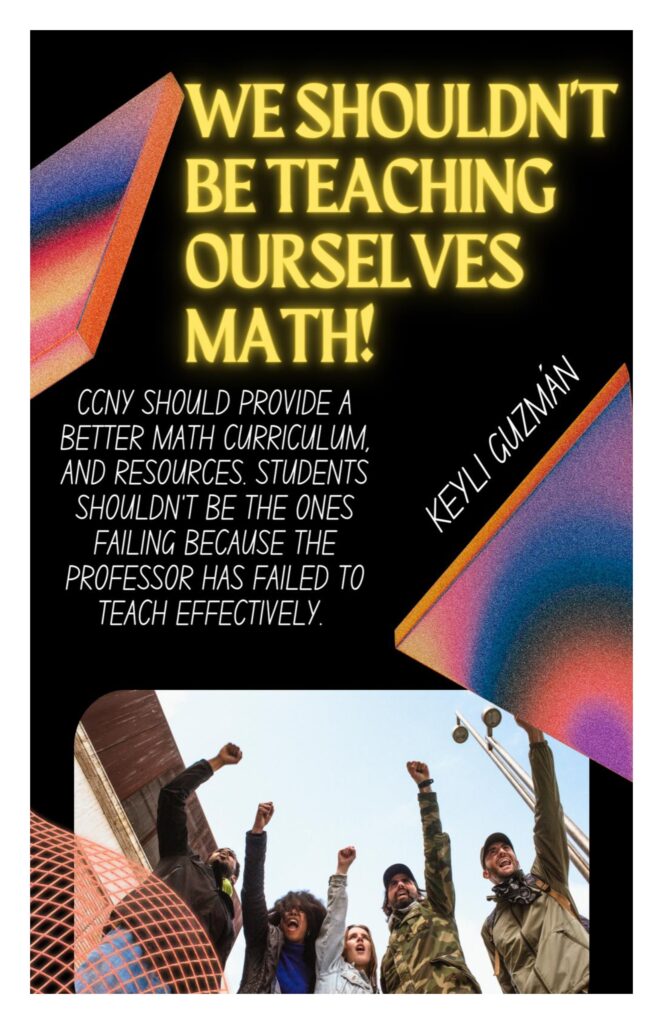
Contributors:
Sarah Cohn (The City College of New York, Library)
Natalie Nuzzo (Brooklyn College, Secondary English Education & English)
George Vachadze (College of Staten Island, Economics)
Roberto Visani (John Jay College of Criminal Justice, Art and Music)
Student Contributors:
Brooklyn College
- Jeanette Davila
- Joann Gomez
Hunter College
- Gina Di Graziano
- Roman Garnica
- Yasmin Herrera
John Jay College of Criminal Justice
- Destiny Baxter
- Caroline Rivera
- Alexander Rosario
- Sunny Lee
- Esther Vandervelde
City College of New York
- Alexa Aviles
- Keyli Guzman
- Antonio Johnson
- Bora Kucur
- Jannat Mahi
- Christopher Neira
- Mhelvin Prangan
- Catherine Reith
Crumbs, Pedagogies of Care, and Instagram: A TLH Public Knowledge Project
By Elvis Bakaitis, Farrah Goff, D’Weston L. Haywood, Christen Madrazo, Emily Raboteau
During one of our first TLH seminars, we discussed what it means to treat students with care. What does it mean? What doesn’t it?
Inspired by the work of Hooks and other feminist theories and frameworks, Pedagogies of Care emphasize creating supportive environments and fostering positive relationships in the classroom. They focus on empathy and compassion in the classroom. They prioritize relationship building, emotional support, inclusive practices, authentic engagement, empowerment, and agency. Pedagogies of Care ask us to remember that our students are real people, people with thoughts and feelings and fears, all which can (and do) affect their learning experiences. In short, what we said on that day in the seminar stuck with us: How we connect with our students (each and every one of them!) is something fundamental, something crucial – it creates the bonds between us within the classroom. Care matters.
As part of our reflection on connection and care, we asked a perhaps obvious question: Particularly in the wake of recent years’ collective traumas— COVID, George Floyd, school shootings, political unrest— we wondered, were our students okay? Had anyone held space for the complicated emotions, or even asked them?
Anecdotally, most of us had asked our students — either individually or collectively —if there was anything wrong, or how we could help. In fact, it seemed we talk a lot about what’s “wrong” in the larger world. We talk about what’s unfair, what’s unjust, what CUNY is lacking, what’s missing from our global and local worlds. With administrators and colleagues, we also have conversations about what our students are missing, about what they “can’t do” in the classroom and beyond. Our students hear and experience this energy, of course. They’re listening. We ask them to reflect on problems, what they could do better, what went awry, how to solve real and hypothetical contemporary social problems, and so on. As educators, surely it’s our job to foster students’ ability to question everything, to point out the problems, and encourage them to shout from the (physical or digital) rooftops! We must push our students, ourselves, and our world to be better, to not ignore or oversee or accept these wrongs. If we don’t do it, who will?
But had we ever asked students what’s going right? Had anyone carved out a space for students to share their joy? Or asked them to go out and find some moments of joy, however fleeting? To note these emotions, to honor the experience, to qualify a feeling of joy, to record or allow this abundant positive energy to occupy space—even for a single moment?
We were also particularly interested in the following question: is the experience of joy an act of resistance, and if so, how? Such a simple but profound exploration and celebration of joy could mark a rather powerful pedagogical innovation.
And so, our TLH small group project—“Crumbs of Joy”—was born. It began with the idea that students should occupy the project’s center stage and that, for sure, as many students as possible should be paid with the funds allotted to this initiative. In the end, 35+ students across 5 CUNY campuses chose to participate.
First, we asked folks to consider the following works:
Luck, 1974
By Langston Hughes
Sometimes a crumb falls
From the tables of joy,
Sometimes a bone
Is flung.
To some people
Love is given,
To others
Only heaven.
Don’t Hesitate, 2010
By Mary Oliver
If you suddenly and unexpectedly feel joy, don’t hesitate. Give in to it. There are plenty of lives and whole towns destroyed or about to be. We are not wise, and not very often kind. And much can never be redeemed. Still life has some possibility left. Perhaps this is its way of fighting back, that sometimes something happened better than all the riches or power in the world. It could be anything, but very likely you notice it in the instant when love begins. Anyway, that’s often the case. Anyway, whatever it is, don’t be afraid of its plenty. Joy is not made to be a crumb.
Our group liked that these pieces exist in direct conversation with each other—authentic dialogue a key practice within Pedagogies of Care—and we set out to invite our students to join the conversation via our Instagram page TLH-@TransformingCUNY because isn’t sharing the joy of the students at CUNY themselves a transformative act?
Next, students were asked to reflect on the “crumbs of joy” they found amidst their day-to-day experience at CUNY, either from home or back in the physical space of the classroom post-pandemic. We provided no real stipulations or length requirements. Students could add to the conversation in the ways that felt organic to them: images, reels, poems, prose, etc.
The students were thoughtful with their responses. They shared “crumbs of joy” moments inspired by nature on their campuses; new prayer rooms dedicated to our Muslim students; the sense of belonging experienced from their involvement with college sports; the safety felt given their campus’ proximity to family, a home-cooked meal and more. The posts were illuminating.
In particular, we were surprised by the string of student responses that explained their joy as linked to feeling “seen” or “heard” by their instructors, despite the fact that we never mentioned Pedagogies of Care principles in our prompts. Our students had no idea that the project was born of conversations about deeply engaging and connecting with them, yet many marked moments that showed exactly that.
For example, here, one student shares how her professor’s words led her to reflect on her place in the physical room post-pandemic:
It was five simple words. “We missed you last week,” my professor had said. I hadn’t thought much of it when I missed a Tuesday class because of a snowstorm but sitting there on Thursday it hit me. Two years of sitting on Zoom classes alone had made me forget the other names in the meeting were my classmates. In my small, fully in-person drama class, I wasn’t just another name on the meeting, I was a person whose seat sat empty when I didn’t come. I had missed them too. I had people to miss again…
In another excerpt from a longer post, one student reflects on a moment of joy experienced when her professor pronounces her name correctly:
The professor walks in carrying an old leather messenger bag. He is so upbeat and energetic, which wakes me up… I’m writing the date on the first page as the professor begins to list the people in the class. He gets to my name, and I look up and say “here.” Wait a second? Did he just pronounce my name right? No one has ever said my full name for the past four years, certainly not the way it’s supposed to be said…I smirk underneath my mask.
Another shares how her professors “actually care [] about what [students] think,” something that’s led to deeper levels of engagement for her:
In high school I spent a lot of time thinking that I was stupid or too lazy to care about school. …now I don’t feel so stupid. Now, when I’m given an assignment, I get excited about what we’re reading. I get it done almost immediately and then get to think about it and talk about it with friends…
And people listen to what I have to say, and they contribute what they think, and the professor actually cares what we think. They don’t think we’re young and dumb. They take everything we have to say into consideration and contribute their own expertise to the conversation. They listen to us like what we say really matters. And if I miss class or an assignment because life gets hard and I’m not perfect, they reach out and make sure that I’m okay. If I’m not okay then they listen and they try to do everything they can to make sure that I’ll be alright for the rest of the semester.
I didn’t know that professors could actually care that much about their students- about me.
A fourth writes:
This is an ode to the crumbs of joy I grab between the sludge of life. To the childlike enthusiasm of my English professor, its infectious glee reminding me that education does not have to be pretentious. To the class I took on a whim that transformed into an opportunity to peek into a world so far removed from me yet feels like home. To the study breaks that turn into therapy that turns into communion…
We hope you will check out the others on Instagram at TLH-@TransformingCUNY.
What emerged through this project is perhaps what was already obvious but worth repeating: as instructors—our care for our students, our moments of connection with them— are making real impacts on real lives. Our students notice. So, let’s keep doing it. As one poster states:
Through all the ups and downs, I never let the downs take away my joy. I’m excited to do it all again next year.
We hope you are, too. Cause if continuing to show up and connect, to find joy and be vulnerable with our students, to give them the benefit of the doubt and to listen and give space, all while still holding high academic standards isn’t an act of resistance, we’re not sure what is.

The screenshot of the Instagram account @TransformingCUNY – shows the main page, with a bio that reads “so excited to share this project, ‘The Crumbs of Joy’ via Transformative Learning in the Humanities.” Below that bio sits a link to information about the TLH Project. The images were submitted by students. They range from landscapes, to desks, to books and lawns from various CUNY campuses.
Event Recap – Life after CUNY: 5-Minute Lessons
By TLH Faculty Fellows Nina Hien, James K. Harris, Anna D’Souza, Meghan Gilbert-Hickey, and Elizabeth Alsop
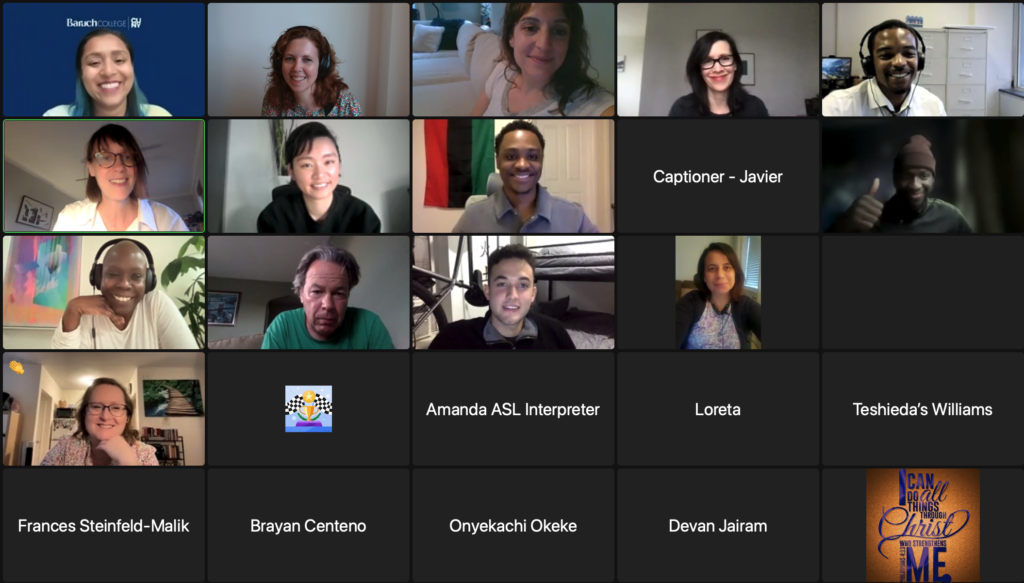
This virtual event featured four CUNY alumni who responded to current CUNY students’ questions about life and career after college. The presentations were showcased at a Zoom event, hosted and framed by CUNY students.
Celia Au, a recent alumnus of Berlinale Talents 2023, is well known for playing a variety of characters across Netflix’s Wu Assassins, Comedy Central’s Nora from Queens, and AMC’s Lodge 49. Au believes the power of storytelling is to change perception and her producorial slate is centered around uplifting AAPI voices. Her current projects include an untitled cooking show in co-production with Hearst Media Productions, a TV show and 3 feature films in development. She recently produced a Music Video Don’t Give Up by artist Calistar and directed by Ron Yuan. Her films were nominated at the SoHo International film, Asian on Films and her VR project premiered at Cucalorus film festival. In addition to acting and producing, Au has been an outspoken activist in the AAPI community and has spoken at engagements with Goldman Sachs, IPG group, AEG Studios, Wash the Hate, Act to Change, and others. In 2020-2022 Celia was named the “Ambassador of Hope” at the Rise Above the Storm Gala. Celia is a graduate of CUNY Baruch.
Celia advised students to make their own experiences at CUNY. There wasn’t a major at Baruch that matched her career so she used both her courses and Baruch’s location in Manhattan to create her own learning experiences. Using a combination of coursework, internships, jobs, and other opportunities in the city, Celia created not only her own major at Baruch, but mapped out a future focused on telling stories as a way to bring people together.
Jaleel Thomas hails originally from Chicago and is a current resident of the Bronx. Professionally, he currently works on Wall Street and as an entrepreneur, as CEO of the designer fashion retailer, BELAUDED. Jaleel has earned several awards including the Streetwise Partners-Barclays Leadership Award, Dream Builders Foundation Scholarship Award, and the prestigious Baruch’s Class of 1984 Student Activities Award.
Remarkably, Thomas is a founder of his own award, the Kalief Browder Memorial Scholarship, given to ex-convicts for their achievement of higher education. Throughout his collegiate experience, he has advocated in office and on the streets for Black rights, student rights, teacher rights, and social justice. Starting as a member of the Black Male Initiative, Jaleel has served as President of the Student Government Association, President of the Entrepreneurship Club, and a delegate of the University Student Senate steering committee at Bronx Community College. At Baruch College, where he is an alumnus, he served two years as the President of the Black Student Union. Finally, he is a proud member of Kappa Alpha Psi Fraternity, Incorporated.
Jaleel advised students to get involved in their campus communities. The organizations he was a part of at CUNY became not only a family but a way to learn about the world and its diverse lives and perspectives. He underscored the importance of advocating for oneself but also listening to others and learning from them. He talked about seeking supports after transfer and spoke passionately about how important it was for students to get to know people who could help them navigate campus and academic spaces.
Ousman Dukuray is a CUNY Guttman graduate with a degree in Information Technology. A combat sports enthusiast with a deep passion for storytelling. Currently works as an Associate Producer for WEBTOONS, managing series like Not Even Bones, Red Hood, Outlaws, The Last Bloodline, and several more in pre-production.
Ousman advised students that passion is the most important thing. He reminded them that the energy and passion they put into school and life will be legible to those around them. He recommended that students be open to careers outside of their major–Ousman thought cartoons was too risky a field, but IT was a reliable major. However, his passion and openness to a variety of options led to his position as a WEBTOONS producer.
Saira Johnson-Qureshi joined the U.S. Centers for Disease Control and Prevention (CDC) in 2012 through the Presidential Management Fellowship (PMF) program. She graduated in 2012 from CUNY-Baruch with her Masters in Public Administration through the National Urban Fellowship. National Urban Fellows are mid-career professionals who apply their expertise and contribute their leadership skills for the betterment of their communities and the nation. Prior to joining CDC, Saira was a Lecturer in Gender and Women’s Studies at Arizona State University for more than 10 years and worked as a coordinator with Donor Network of Arizona, coordinating organ/eye/tissue recovery for transplant for the State of Arizona.
In 2013, Saira began working in CDC’s Division of Global HIV/AIDS and TB (DGHT) as a Regional Desk Officer covering West Africa and the Americas. DGHT is the CDC implementing arm of the President’s Emergency Plan for AIDS Relief (PEPFAR) which provides HIV/AIDS relief services to 20 countries around the world on behalf of the U.S. Government as of 2022. Since joining DGHT, Saira has traveled to more than 15 countries to conduct programmatic assessments, provide technical assistance, lead management and operations, facilitate training and so on. Saira has been detailed to the Department of State multiple times and has worked in multiple U.S. Embassies around the world. She is currently based in Nairobi, Kenya serving as the Associate Director for Partner Management, managing approximately $130 million dollars and a portfolio of over 30 implementing partners.
Sarai advised students not to doubt themselves, especially in new spaces. They’ve done new things before, often with great success, and need to remember and focus on their why. She recommended that students be open to changes in major and, more broadly, to meandering, non-linear routes through life and career. Once students have their degrees, they can use it to go in so many varied directions. She noted that students will likely change jobs and even careers over the course of their lives. We each own your experience and the choices we make.
In addition to providing five-minute life lesson talks, the alumni speakers answered questions from current CUNY students. They spoke about how school schedules may or may not align to work life and availability, whether or not one should change majors, what CUNY-learned skills or experiences were the most useful in their careers, and, significantly, how to define success in life. It was a night of rich conversation, and we celebrated the current and future success of CUNY graduates.
Fellows Project: (Re)Mapping Knowledge
Organized by Kimberley D. McKinson (John Jay College of Criminal Justice), Tatiana Nuñez (Graduate Center and City College) Micheal Rumore (Baruch College) and Stefanie Wess (Lehman College, Hunter College and Queensborough Community College).
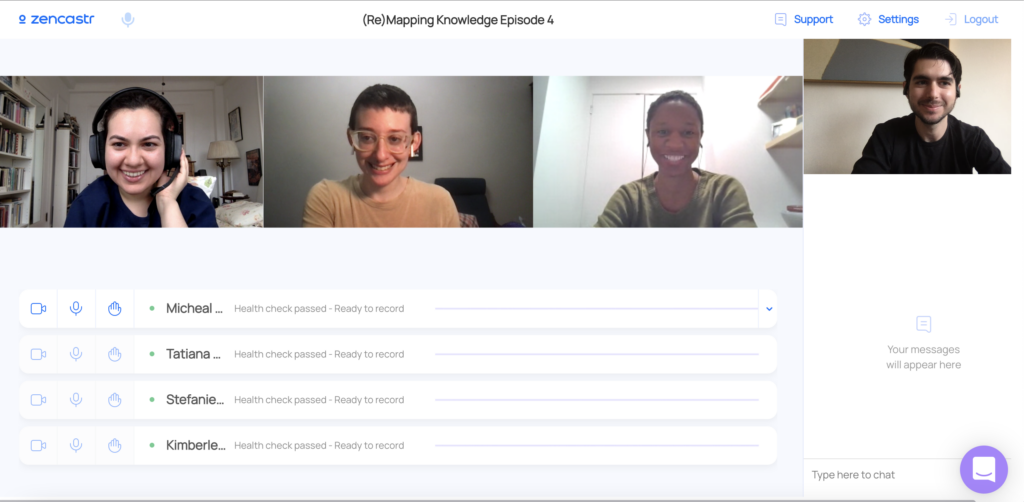
(Re)Mapping Knowledge is a student-faculty collaborative podcast project that showcases the creative scholarship of CUNY students and also serves as a critical pedagogical tool for the wider CUNY community. Featuring the creative scholarship and storytelling of CUNY undergraduate students, this four-episode podcast series highlights innovative and radical pedagogical approaches as well as the possibilities that emerge from incorporating student-produced and student-centered knowledge in the classroom.
Drawing on the writing and research of student-scholars, episodes 1-3 of the project highlight different pedagogical approaches to (re)mapping knowledge in the classroom. Episode 1 interrogates the relationship between self, community, language, and textuality. Episode 2 discusses classroom strategies for confronting the coloniality of literary traditions. Episode 3 uses student autoethnography to center embodied knowledge as decolonial pedagogy. Episode 4 of the project features a moderated conversation between the three Faculty Fellows on the themes, teaching tools, and strategies illuminated in Episodes 1-3. In this way, Episode 4 not only serves to frame Episodes 1-3 but also serves as an accompanying teaching tool in its own right, including a discussion of innovative approaches to teaching and reading canonical texts.
(Re)Mapping Knowledge provides CUNY students and teachers the opportunity to problematize the notion of the canon and also allow for meditations on the radical ways in which knowledge can be produced by students in the classroom. The episodes capture student scholarship in a rich way. As a pedagogical tool, (Re)Mapping Knowledge provides an example of how faculty can embrace podcasts as a means by which to embrace different sensorial teaching tools that can complement more traditional written texts.
TLH Fellows Project: Creating Across Communities

For our TLH community-facing project, we created a shared site for our classes on the CUNY Academic Commons, centered around the concept of “writing with and for a community.” Each of our courses has a two sub-page on the site: one of which gives an overview of the course and some background, and another of which has blog posts by students, usually with contextualization by faculty members. Then students from other classes read these blog posts and commented on them, sometimes even creating new imagery or artwork in response. In this way, we hoped to foster an intercampus conversation about space and place.
Notions of audience, place, and identity–as well as the use of images–are woven through our courses. Carrie Hall’s Composition II course (NYCCT) focused on how students can best choose and produce in a genre to reach a particular audience. Marta Cabral’s class, Art in Elementary School Education (CSI) learned how to teach art to third and fourth graders. Erica Richardson’s students in Literatures of the Harlem Renaissance (Baruch) blogged about a trip to the Met. In Belinda Linn Rincon’s class, Latinx Street Literatures (John Jay) students watched and blogged about the film La Ciudad, often including images in their blogs. Dominique Zino’s class, Cultural Identity in American Literature (LaGuardia), read literature that address issues of dislocation/relocation, identity formation, and alienation and wrote blog posts about space and power.
The project was, in many ways, a success: students gained a great deal from seeing what is happening on other campuses, and it made their projects feel more real to have a live audience for their blog posts. Carrie Hall’s class had the option of writing a unit with a fourth grade audience in mind, and the respondents, Marta Cabral’s class, were in training to be fourth grade teachers which allowed for vibrant visual feedback. It was also a great benefit also to have a variety of course levels so that beginning writers could see what upper level students are doing, and upper level students could take on a mentorship role and reflect upon how far they’ve come. That said, we did also have our struggles. Much of these had to do with scheduling and planning; we struggled to find anyone to assist with web design and needed to do it ourselves. Also, because we didn’t have our project in play until well into the semester, we didn’t have time to seamlessly plan in a way that would best benefit the project and the students. That said, this is the type of project all of us would be happy to do again with the benefit of experience.
While the public-facing project is mostly the website itself, we will culminate the project early next week with a brief online discussion between the five of us about the website and the benefits and difficulties of intercampus collaboration.
“Money, Power, Respect,” a TLH Faculty Fellows’ Project
By Virginia Diaz-Mendoza
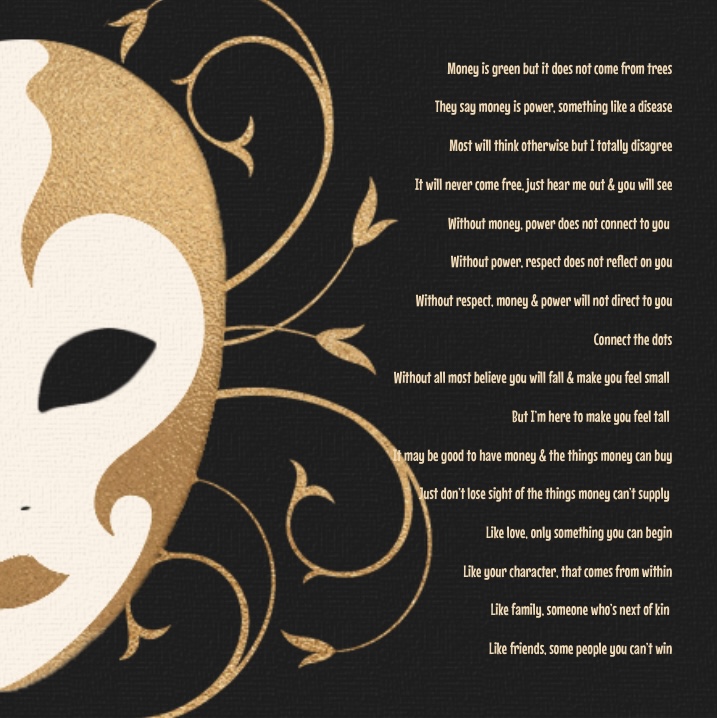
I have been working on a Creative Collaboration with four other faculty members on a project. We created an Instagram account where we can showcase our students’ ideas about money, power, respect, and education. The account handle is @money_power_respect_cuny.
Students are awarded modest TLH student scholarships for producing related scholarship selected for inclusion on the @money_power_respect_cuny Instagram account. Content included on Instagram relates to the topics: money, power, and respect in relationship to education. We encouraged participants to be as creative as they like. The content could be a picture, video, visual representation, or personal reflection about money, power, respect, education. The content could be specifically about one of these topics, some of the topics, or all the topics.
Some guiding questions for students’ content creation:
- What does money, power, and respect mean to you?
- What does money, power, and respect look like, sound like, feel like?
- How does education lead to having or losing money, power, or respect?
- What do you want to teach our followers about money, power, or respect?
- What do you want to teach them about CUNY?
Reflections on the Project
Working with my colleagues from across CUNY campuses was so rewarding. While we didn’t have as much student participation as we hoped for, it was still a great experience to brainstorm and come up with a way to engage students with a topic they find interesting. Initially I posed the invitation to students in my class and only got one student to participate. The instructions were sent via email and posted in Announcements on the EDU280 class Blackboard. I opened the invitation to the entire SEEK population and got another submission from a student who was not enrolled in my class. Both submissions were included on the Instagram account. I believe there was little participation because students were working on midterms and then went on Spring Break. Moving forward, I’ll propose a similar project in my courses but will work on it in class as a community.
The Museum of Us: Student Projects from Arts in NYC at Baruch College

TLH Faculty Fellow Cheryl Smith (English, Baruch College) teaches a course called, Arts in NYC, which is a humanities seminar for first-year students. The final project for the course was a group curation project of an online exhibit around a theme of their choice. Their exhibits are gathered together in what the students chose to call “The Museum of Us.”
Professor Smith tells us,
“This project was profoundly shaped by our work together in the TLH Seminar—our discussions and readings. I see the focus on empathy, care, creativity, voice, and representation emerge in these projects. I’m proud of the work my students did and grateful I could provide a space for nurturing it; I think they were genuinely proud of their work, too. It’s been a long, hard semester for many of us, and it’s so nice to end on this kind of positive note.”
You can view the student group projects on their website (opens in a new window). Projects are titled, “Plugged In: The Playlists of the Pandemic,” ‘“I”dentity,’ “Baruch 25 Student Journal: New Beginnings,” “Pandemic-Centric Inclusivity,” and “Tranquility in a City that Never Sleeps.” Thank you, Dr. Smith and students for sharing your impressive work from the semester!
Imagining a CUNY without Grades: A Podcast and Manifesto by and for CUNY Students
One of the spring Fellows public knowledge projects was a podcast and manifesto, organized by Michael L. J. Greer (Brooklyn College), Gisele Regatao (Baruch College), Rebecca L. Salois, (Baruch College) and Casandra Silva Sibilin (York College). The Fellows were joined by twenty students in a conversational podcast on ungrading. The conversation revolved around the following key questions: How does/could/ should grading work at CUNY? What does grading mean to students? How do they perceive the concept of ungrading? What do they think of the ungrading practices they have experienced so far? Eight of the students asked questions and engaged in the conversation verbally, and the remaining twelve students participated in the written manifesto after reflecting on the conversation that took place during the podcast recording. The result is an engaging recording where students and professors discuss their experiences of ungrading, and explore the function that grades have played in their own lives. Students think about the virtues and potential downsides of ungrading at CUNY, discussing their fears, hopes, joys, and frustrations. The professors weigh in on questions students have around the value of ungrading, and the podcast ends with a brainstorm on how students might participate in creating a CUNY without grades. The collective manifesto that accompanies the podcast declares a vision for what a CUNY without grades would look and feel like. The podcast, manifesto, and a list of resources on ungrading are compiled on the website Imagining a CUNY Without Grades.
TLH recognized students in several ways: (1) scholarships ranging from $50 to $300; (2) featuring students on TLH’s websites, blogs, and glossy annual reports; and (3) formal letters of gratitude and recognition that students could use for their professional development. Below you will find a few of the letters we sent to students. The first is a letter we sent to those students who completed coursework with a TLH faculty fellow and contributed to a public knowledge project. We sent similar letters to the 80 students who collaborated on our Spring 2021 workshop series. The second is a letter we sent to advisory board members after their term of service. The final document is the letter of recognition we sent to the 45 students who participated in our Student Summit.
In addition to the formal letters of recognition in the section above, TLH also advised students on how to use their leadership, public speaking, and collaboration skills they gained from the TLH experience in their future academic endeavors and careers beyond academe. Below is a sample of the advice we gave to Student Summit participants just days after the Summit.





